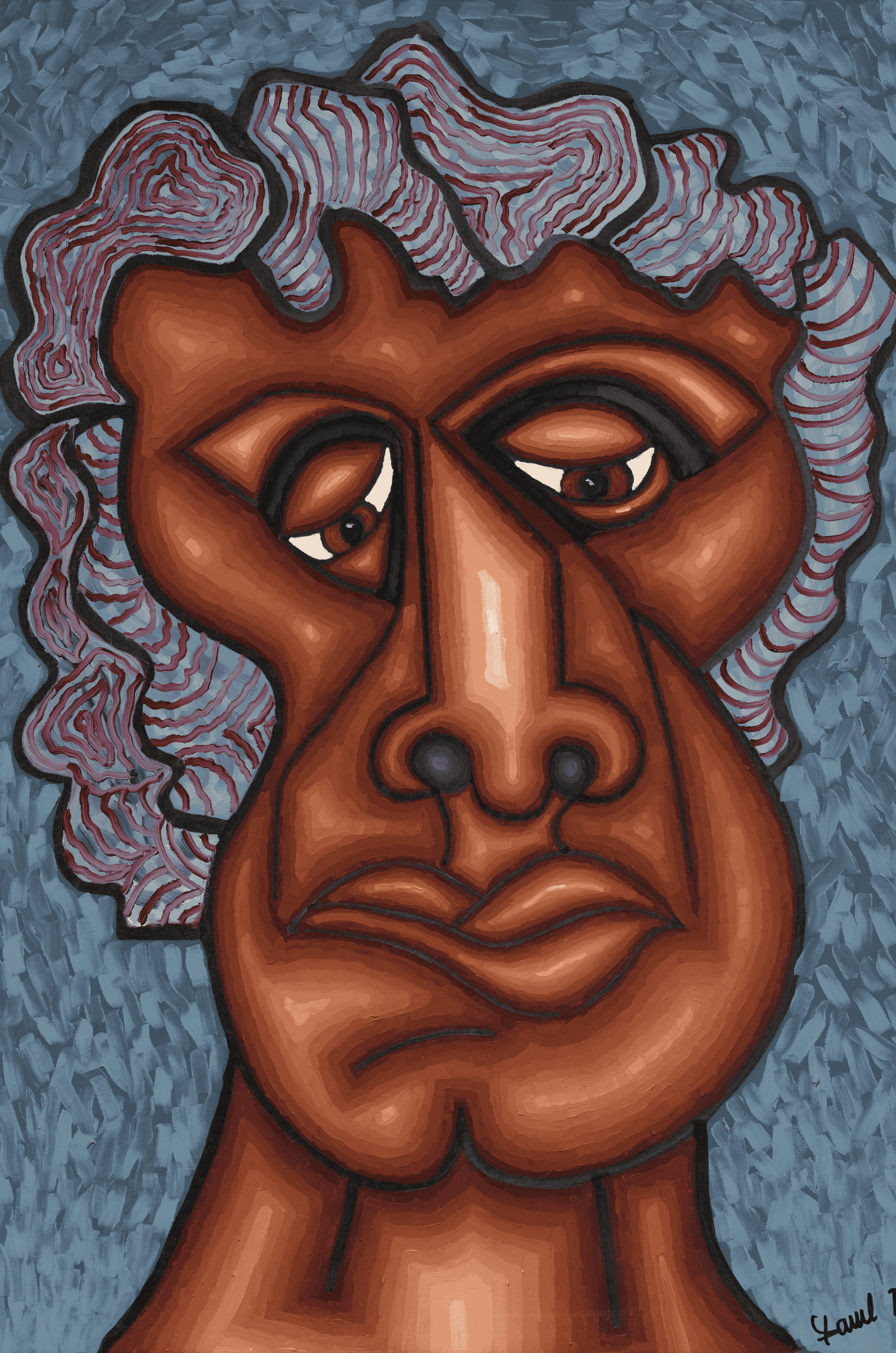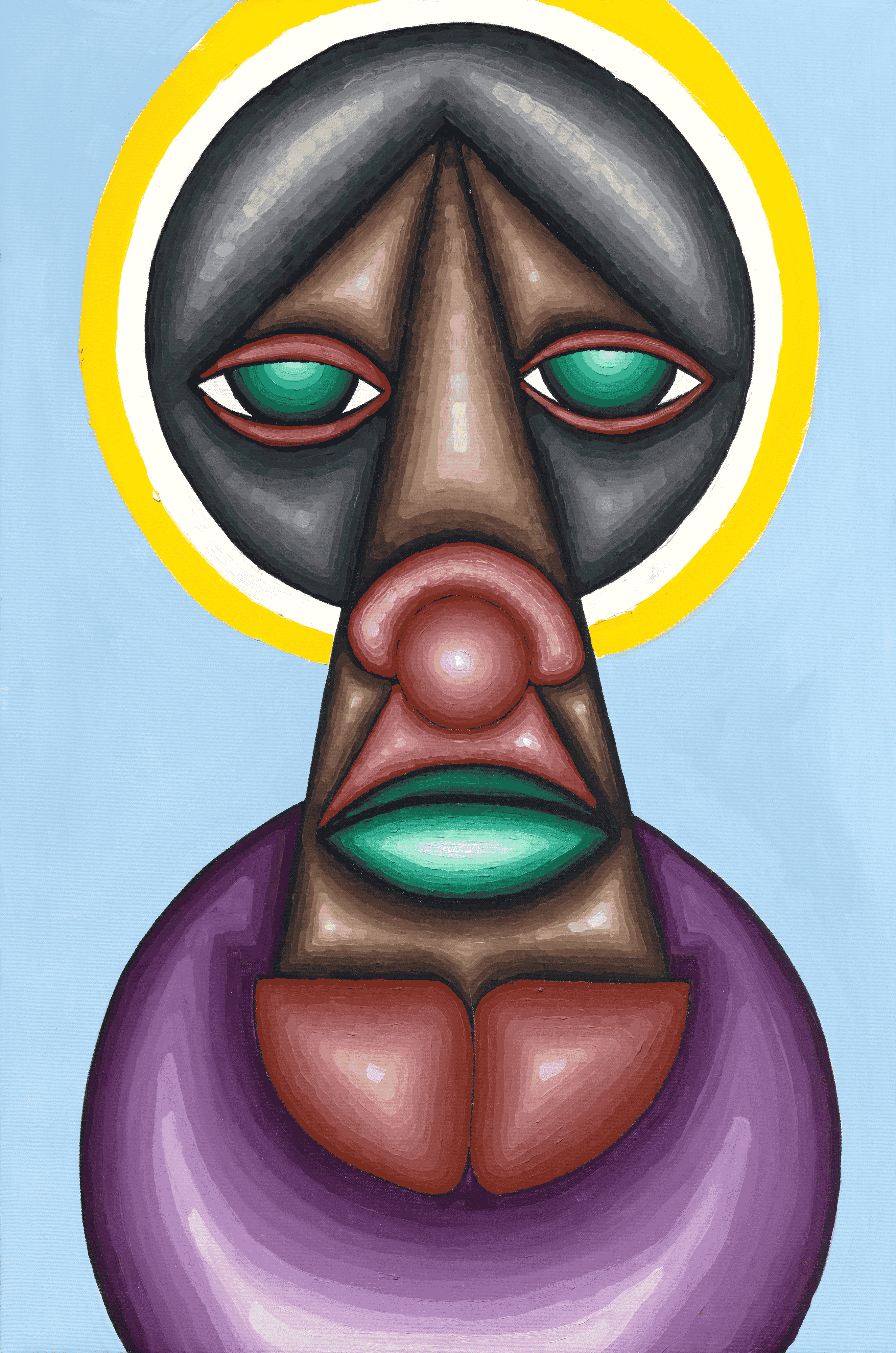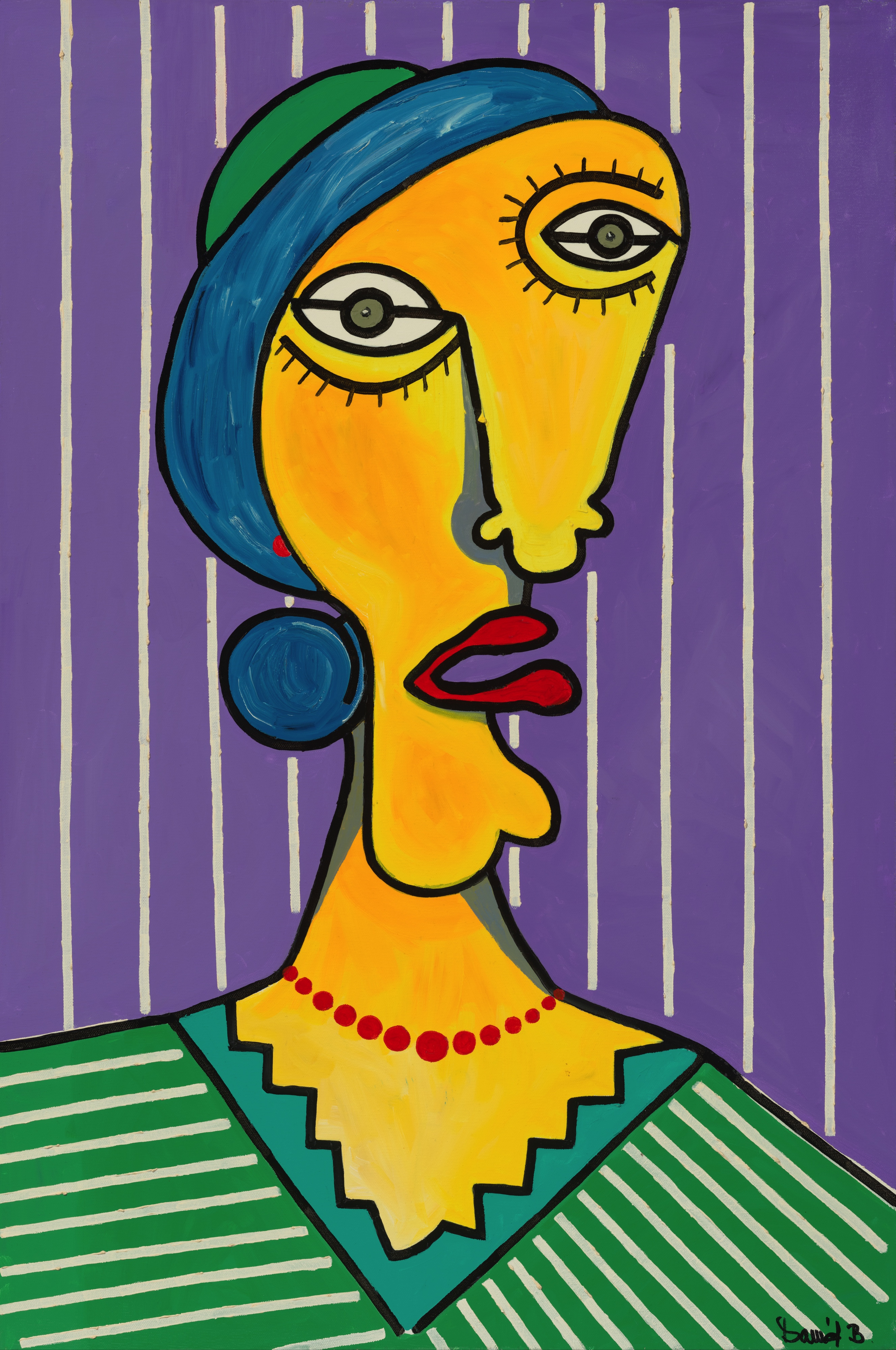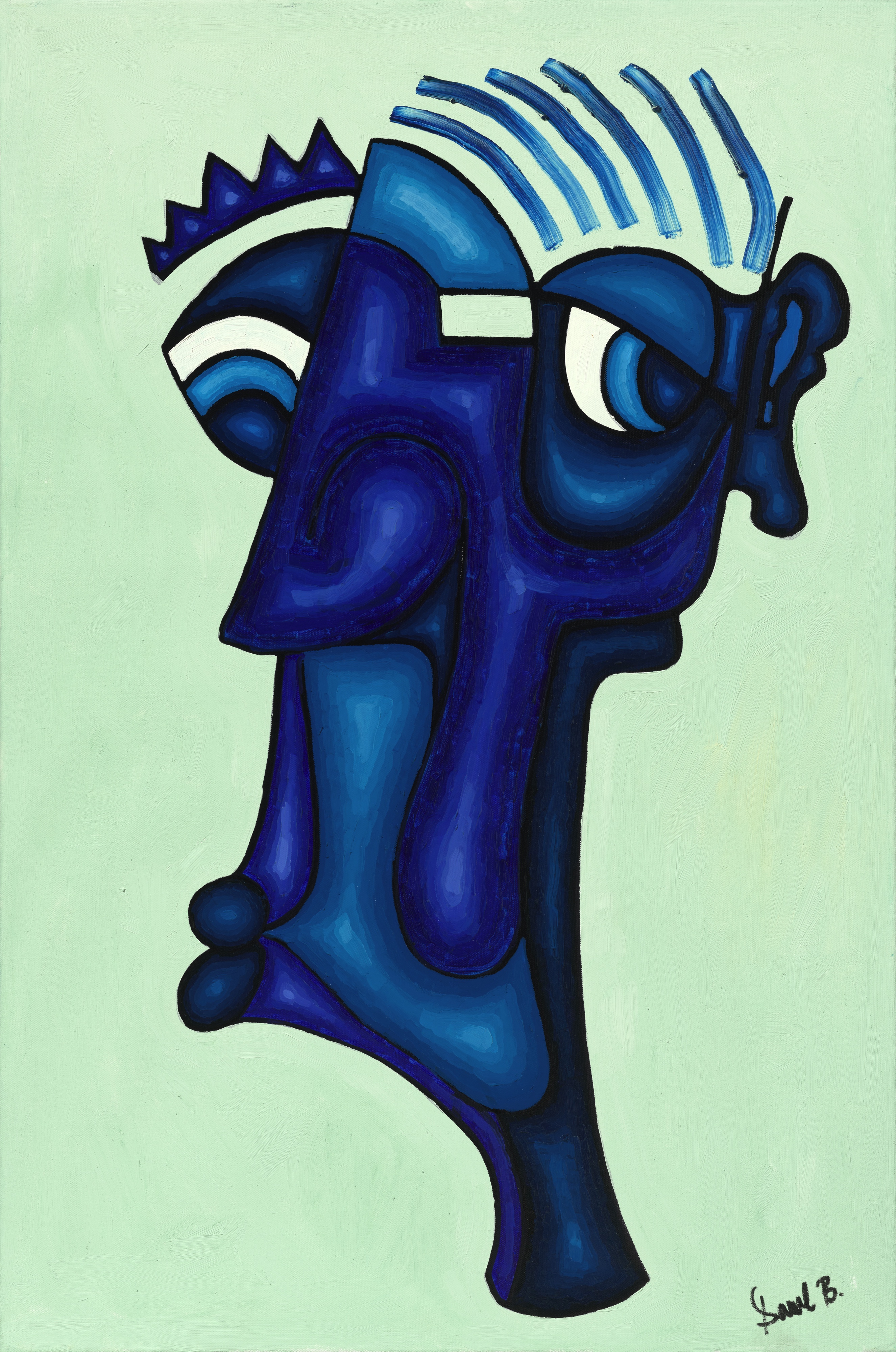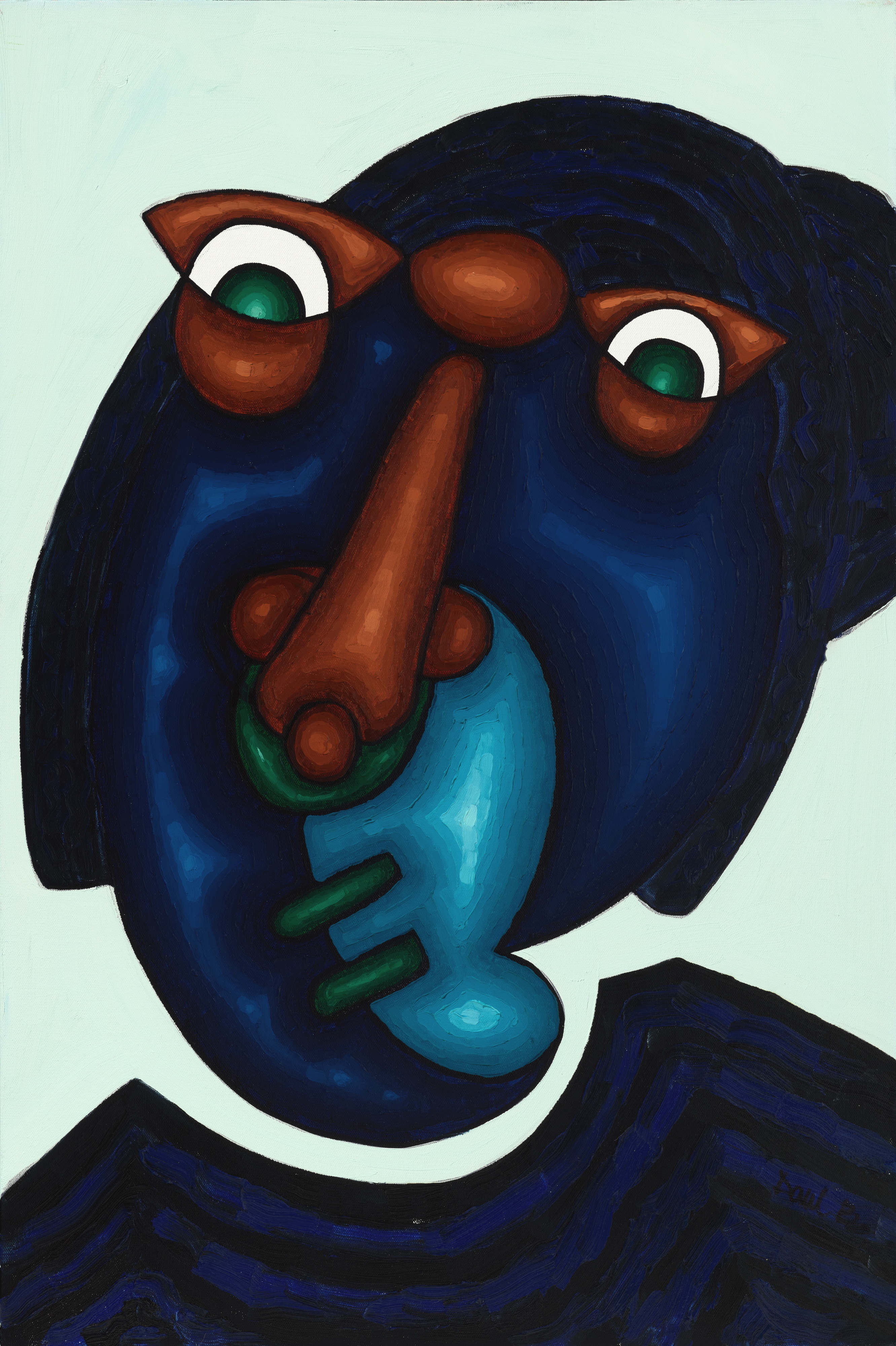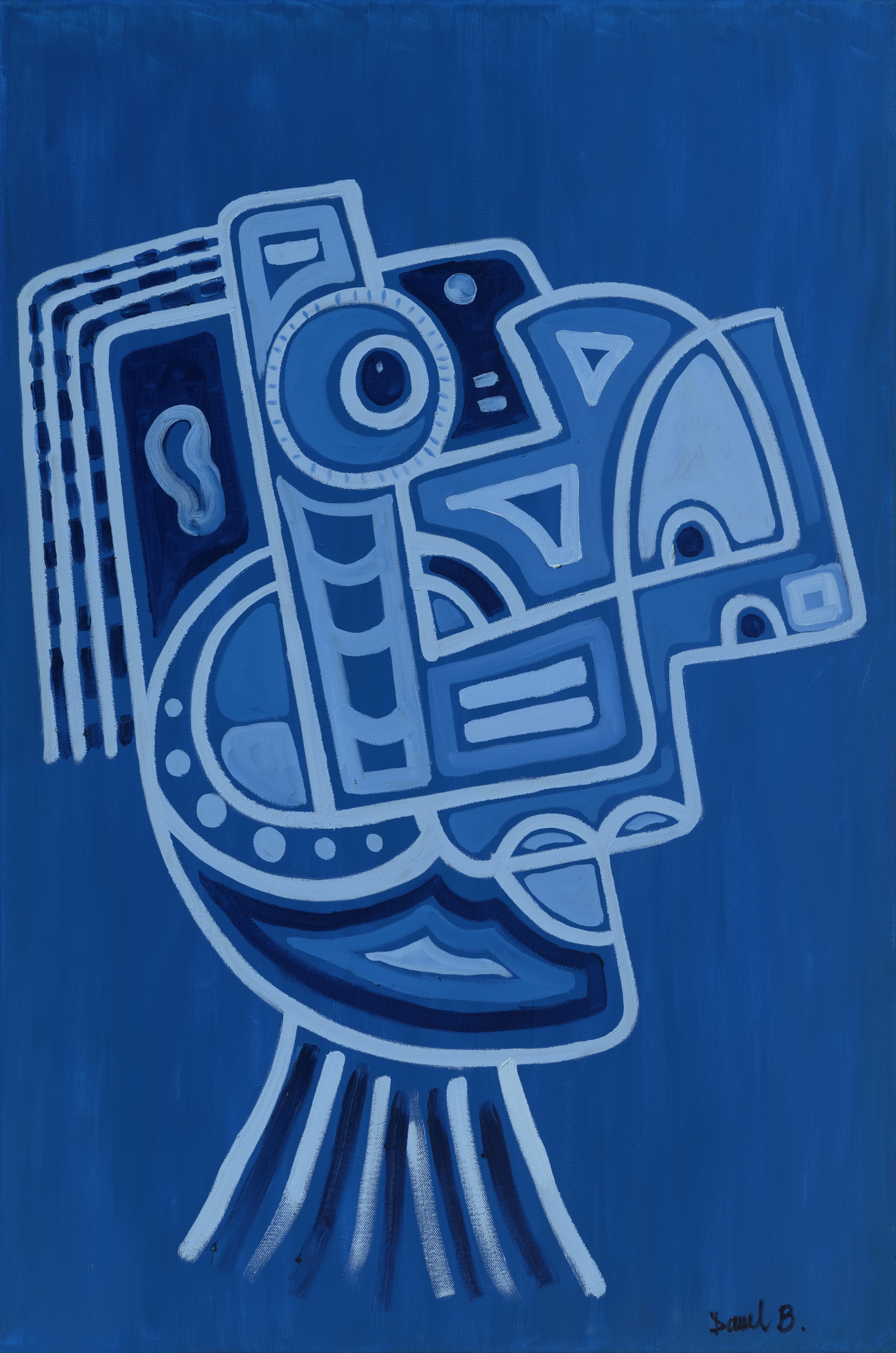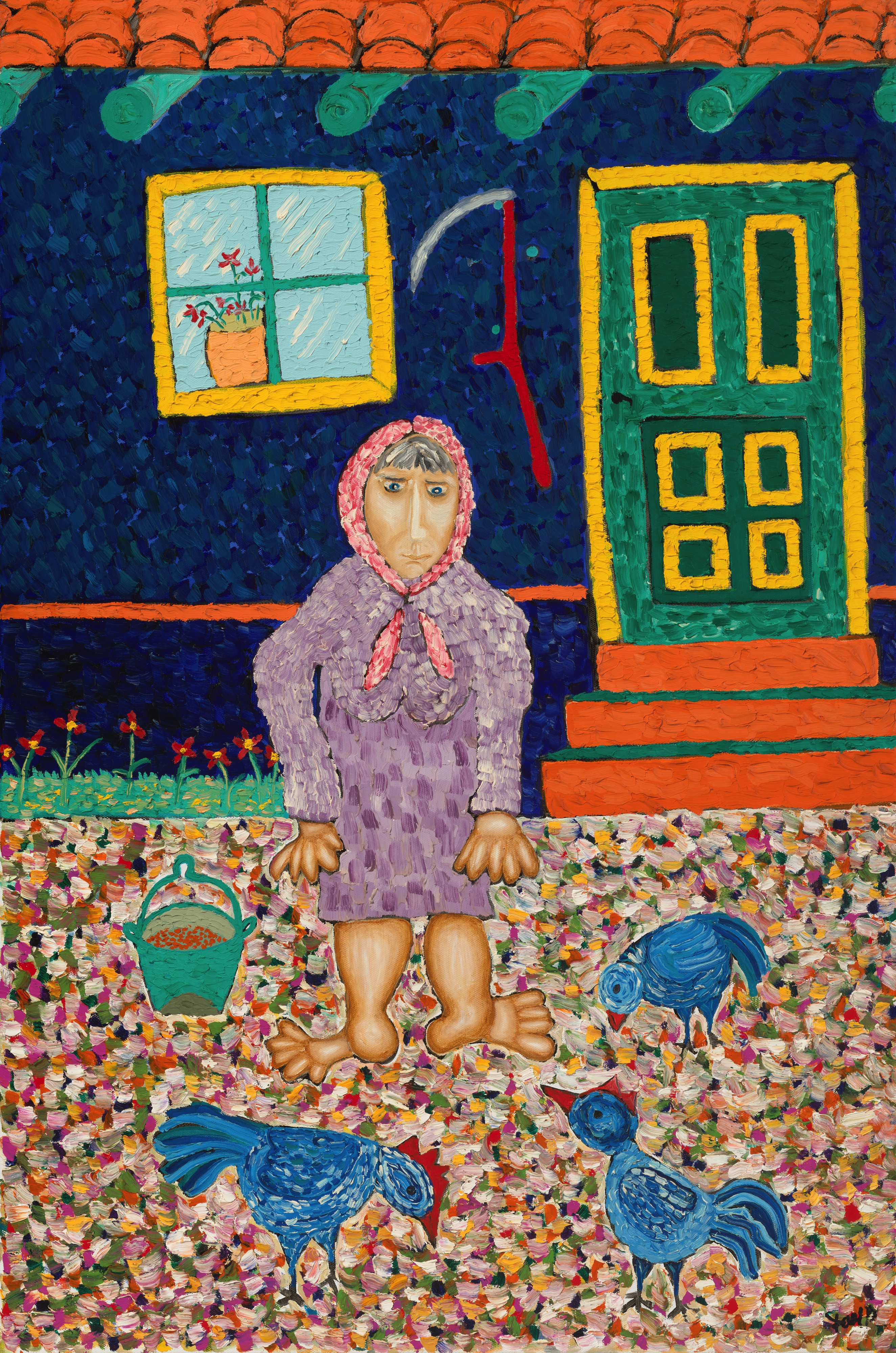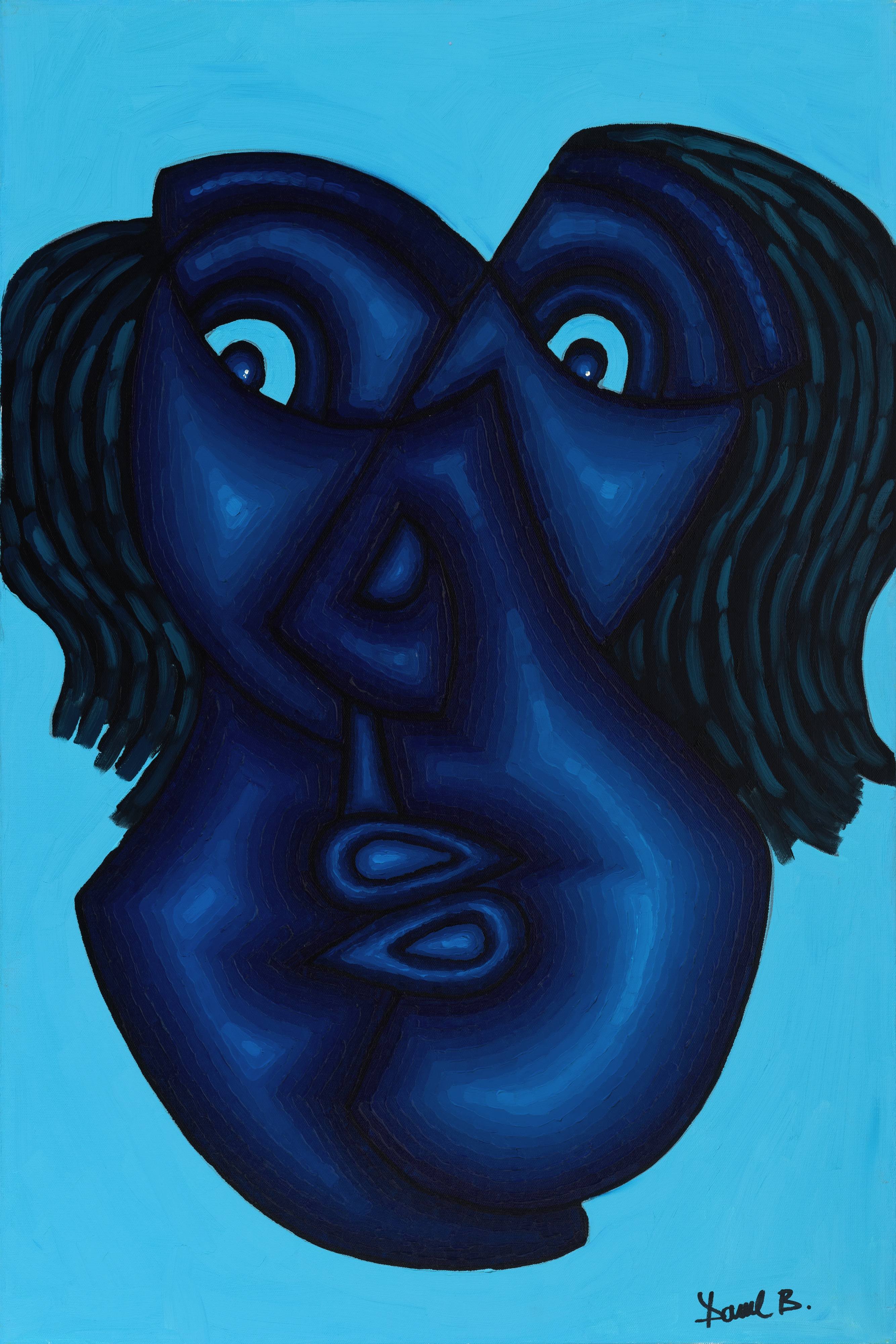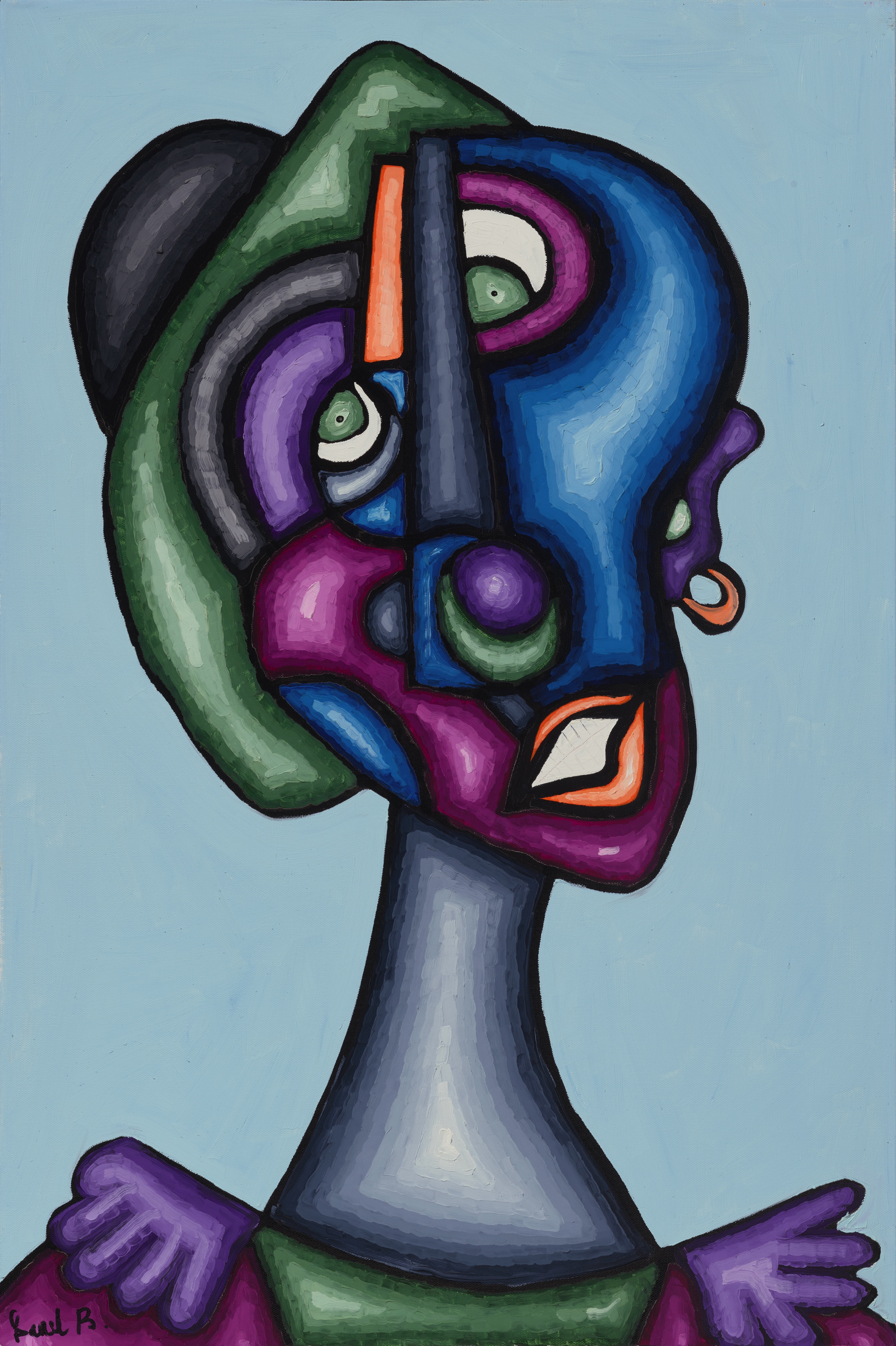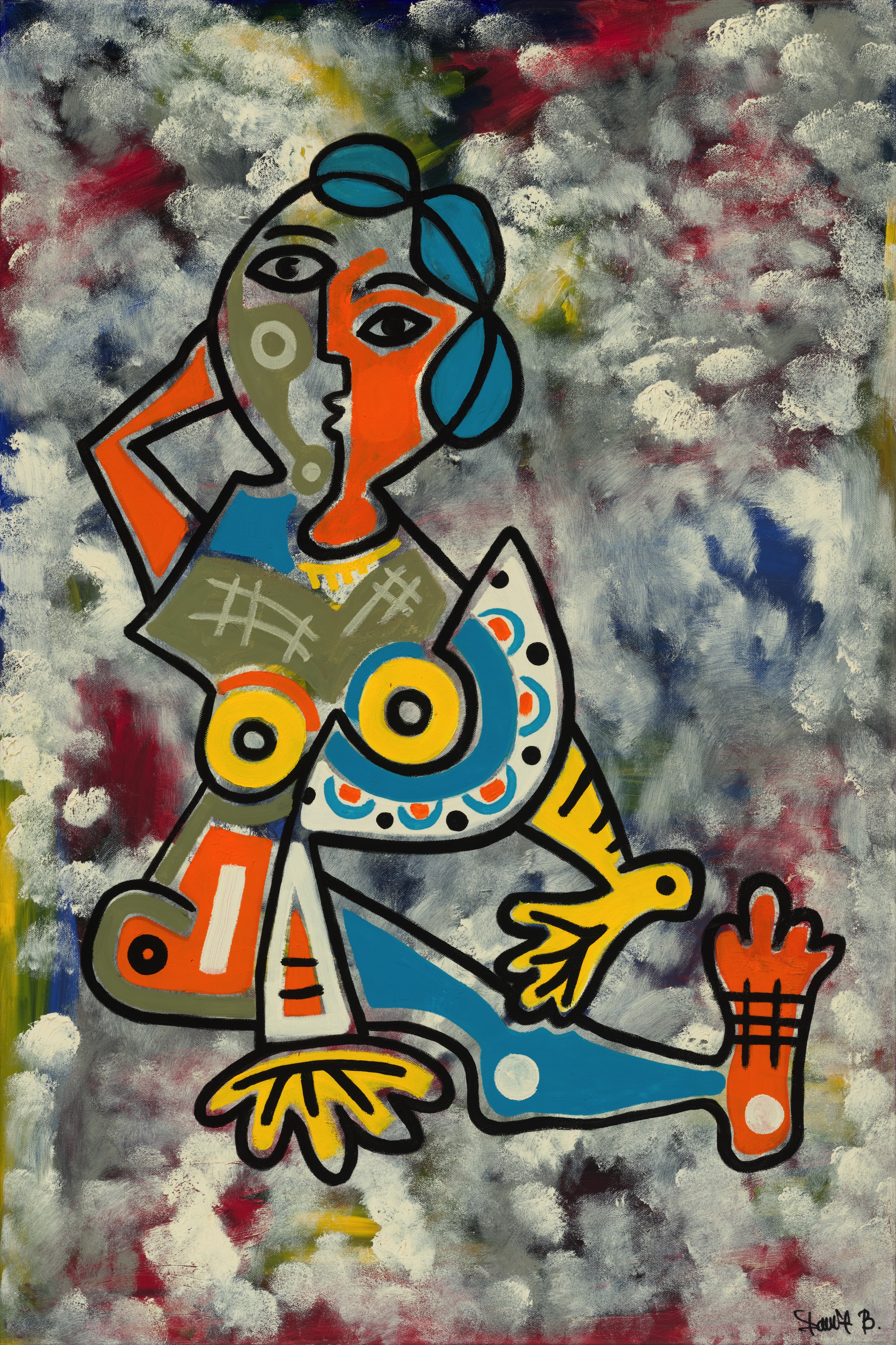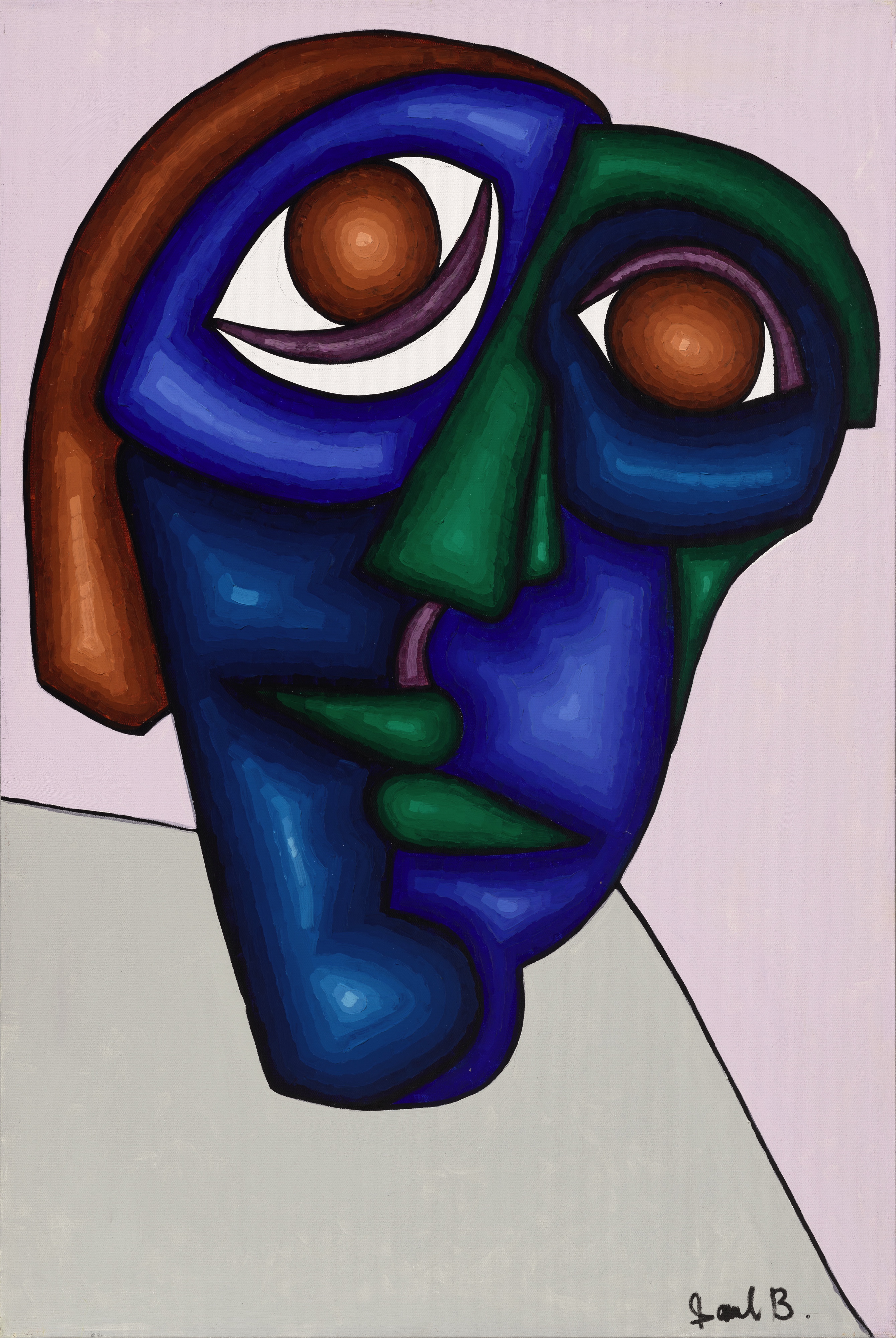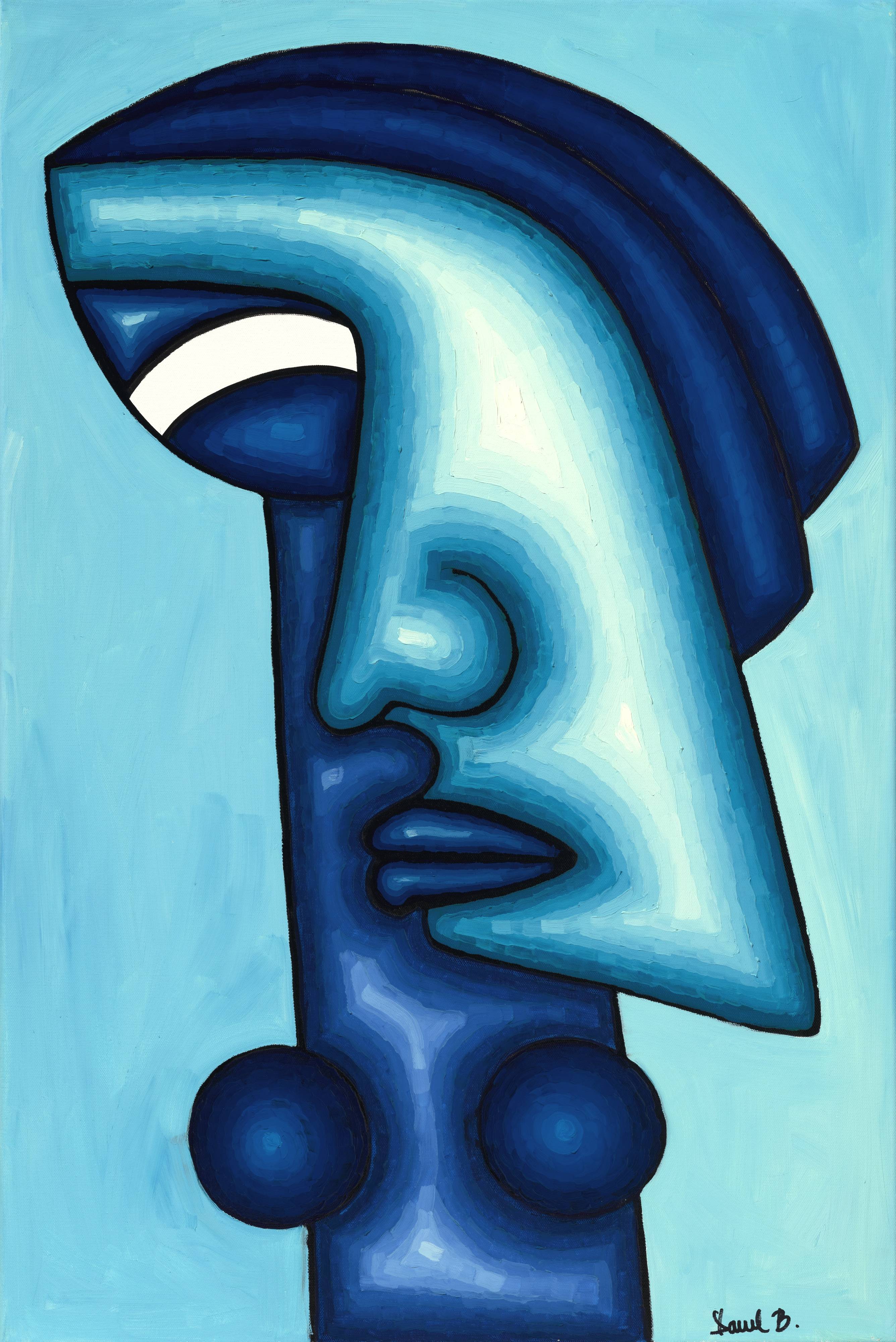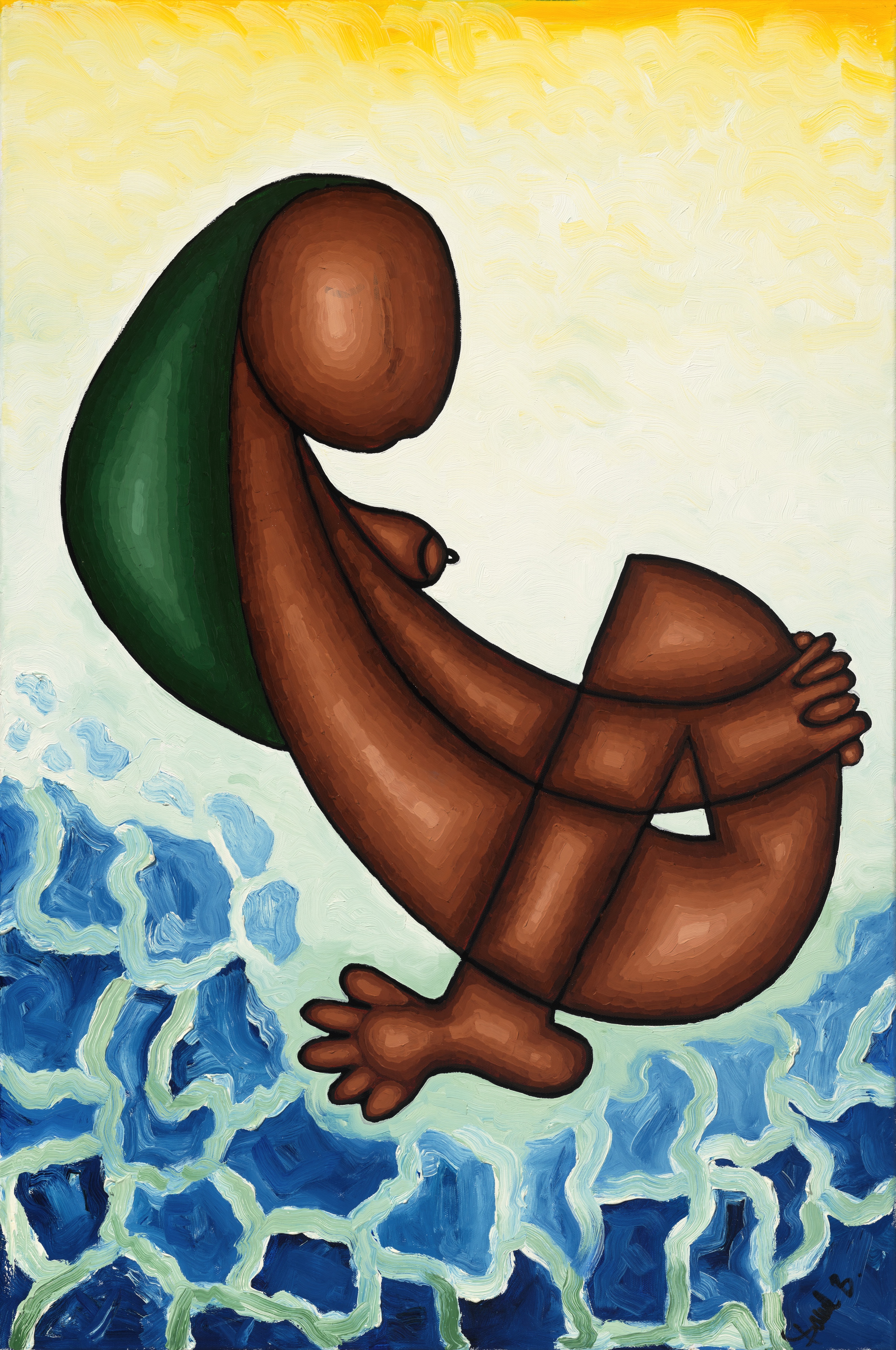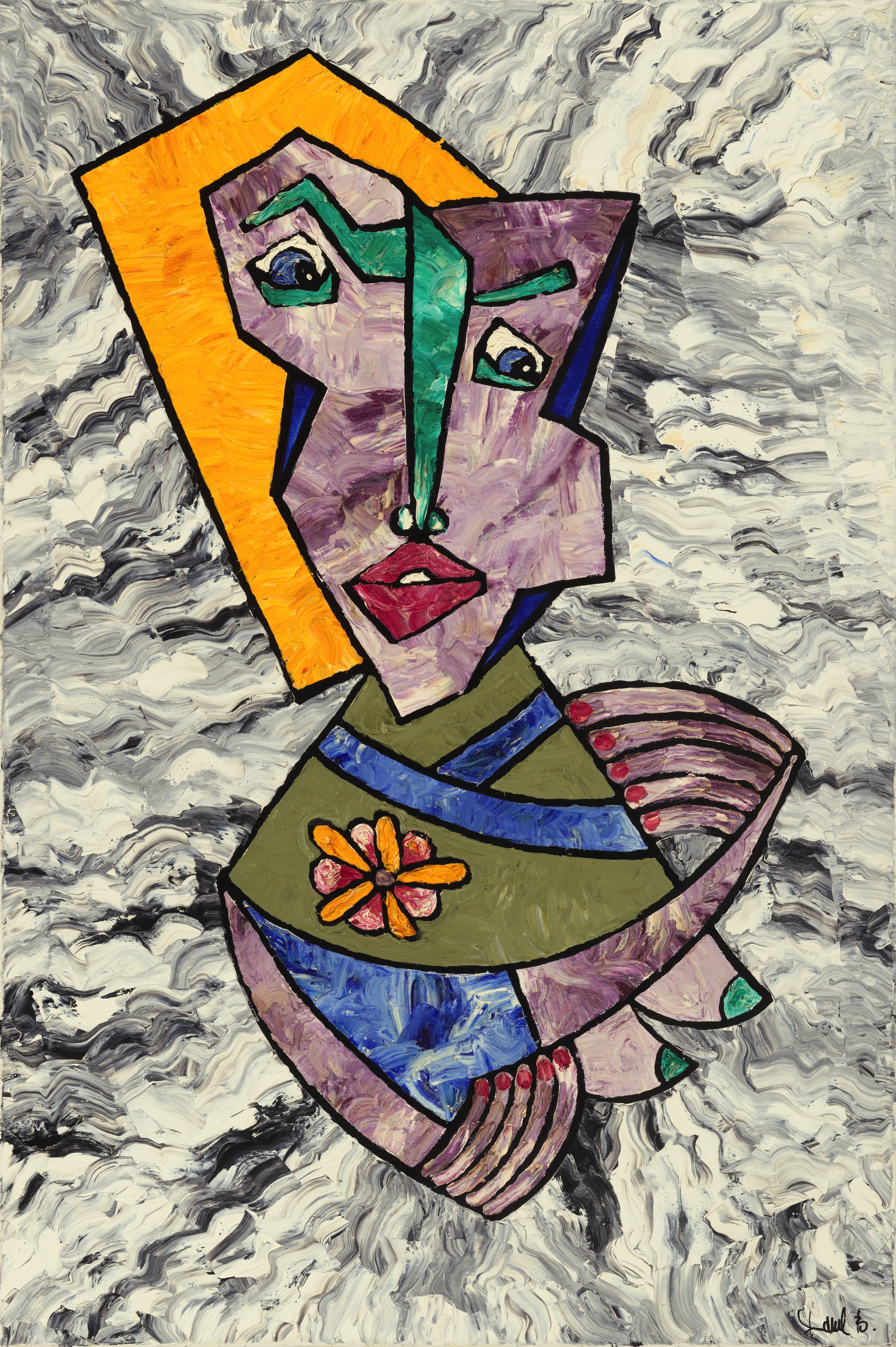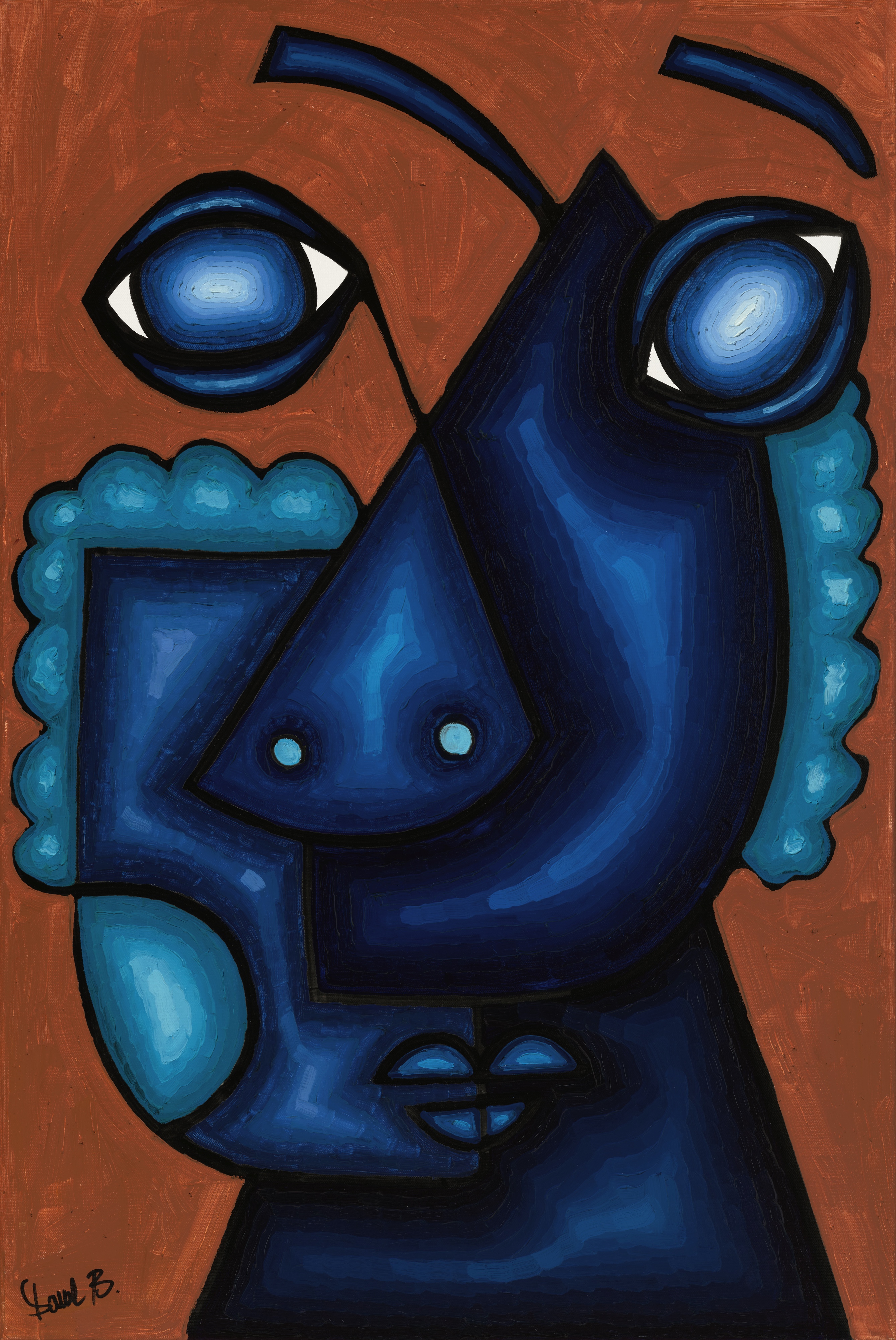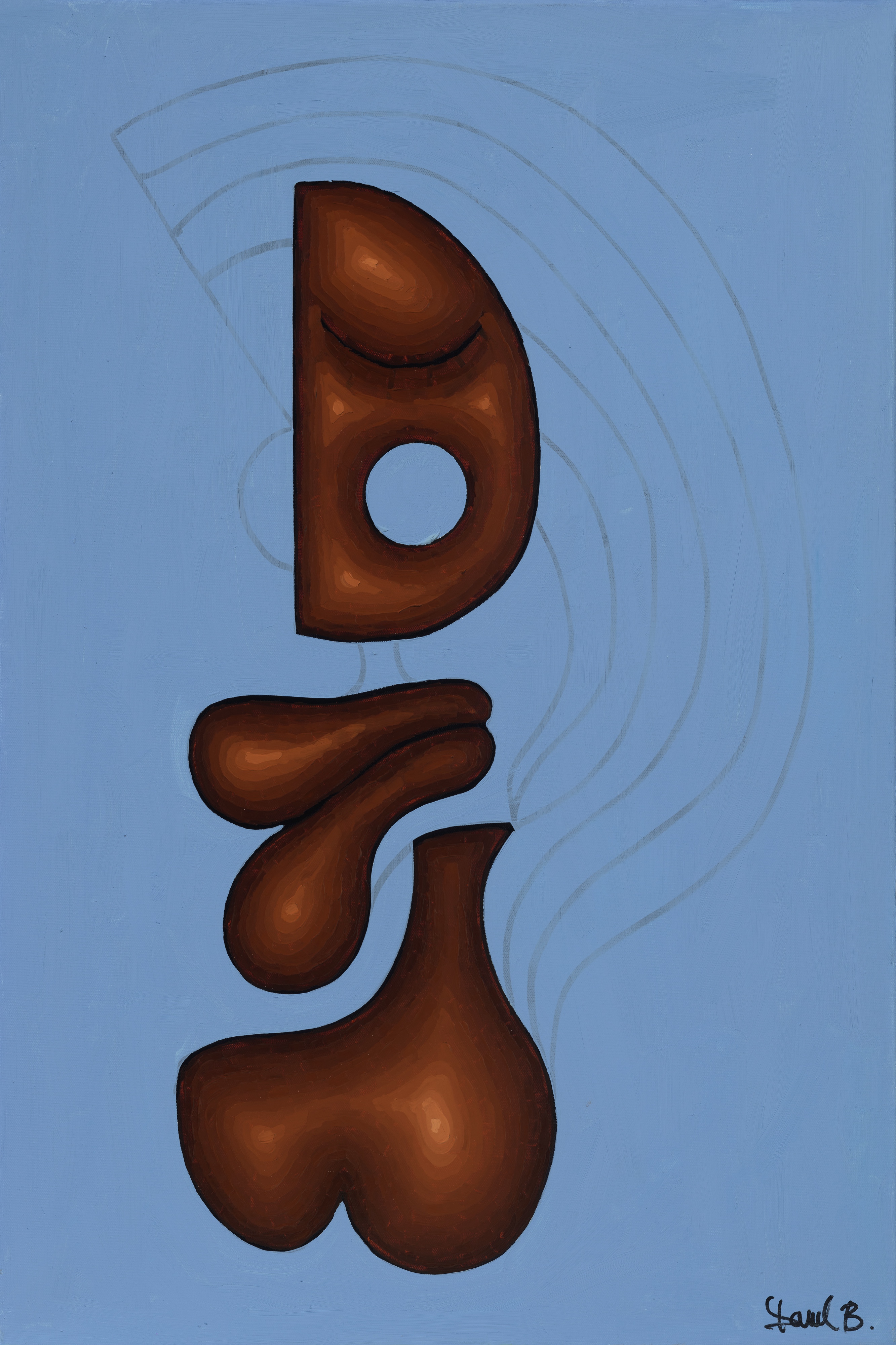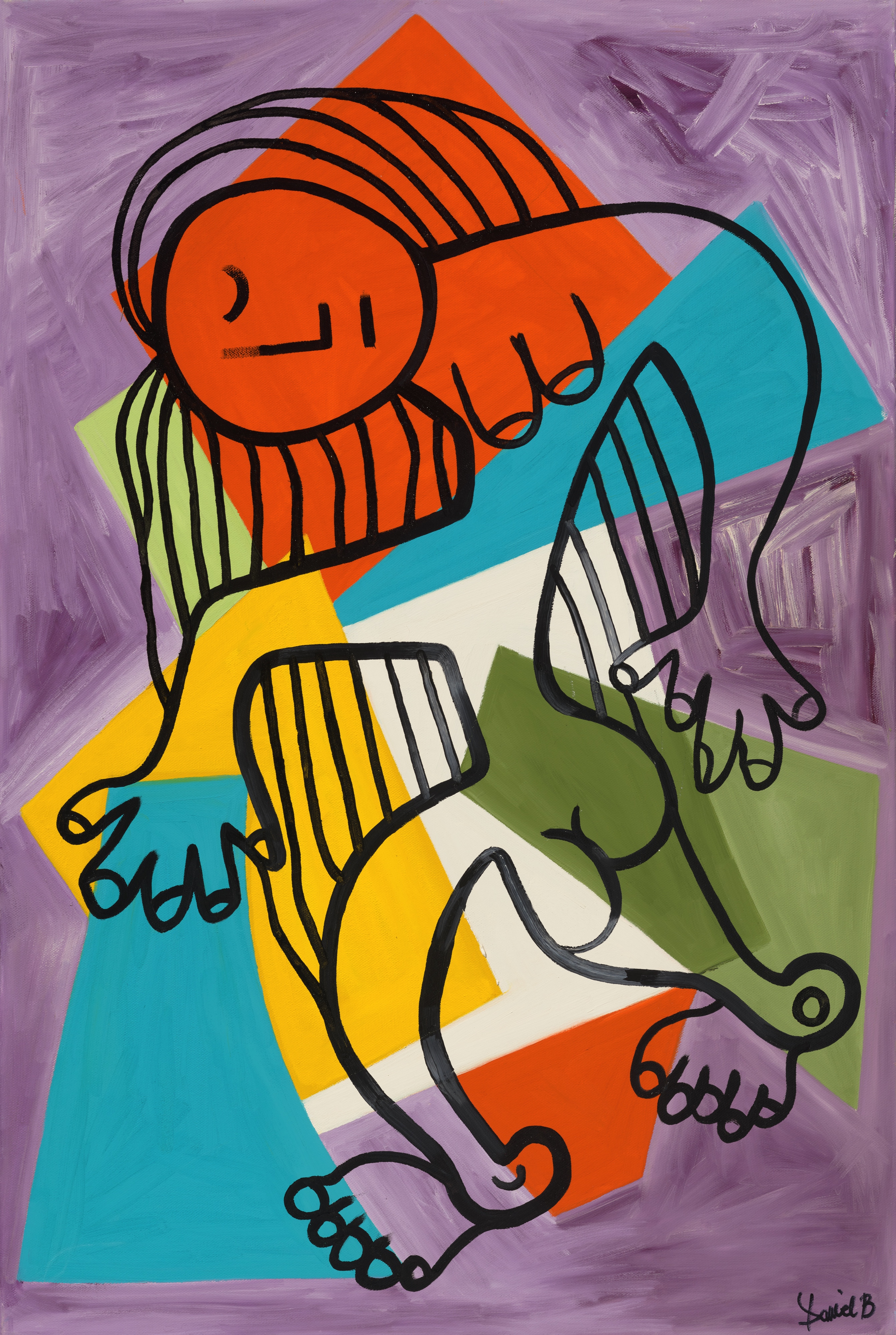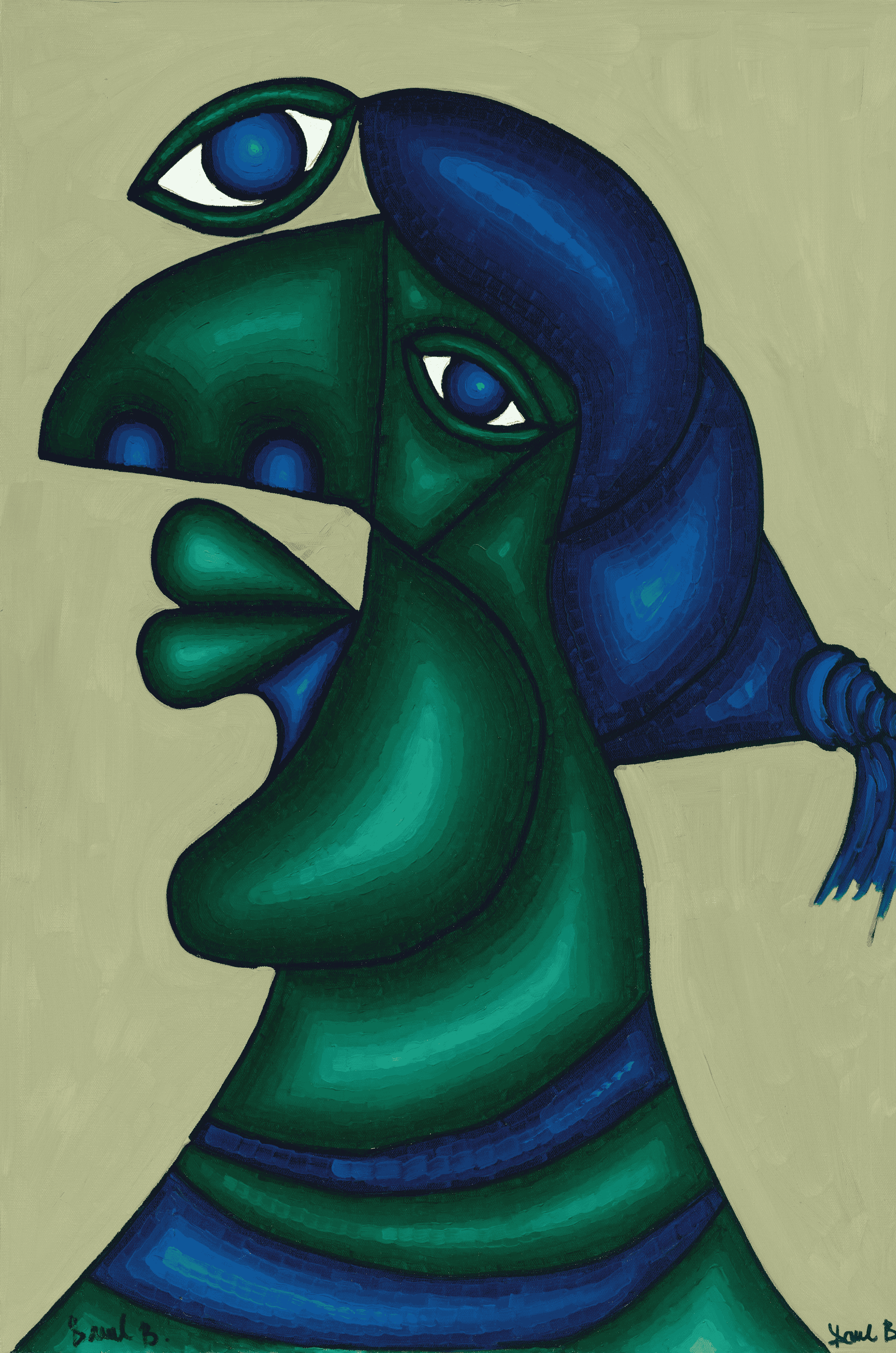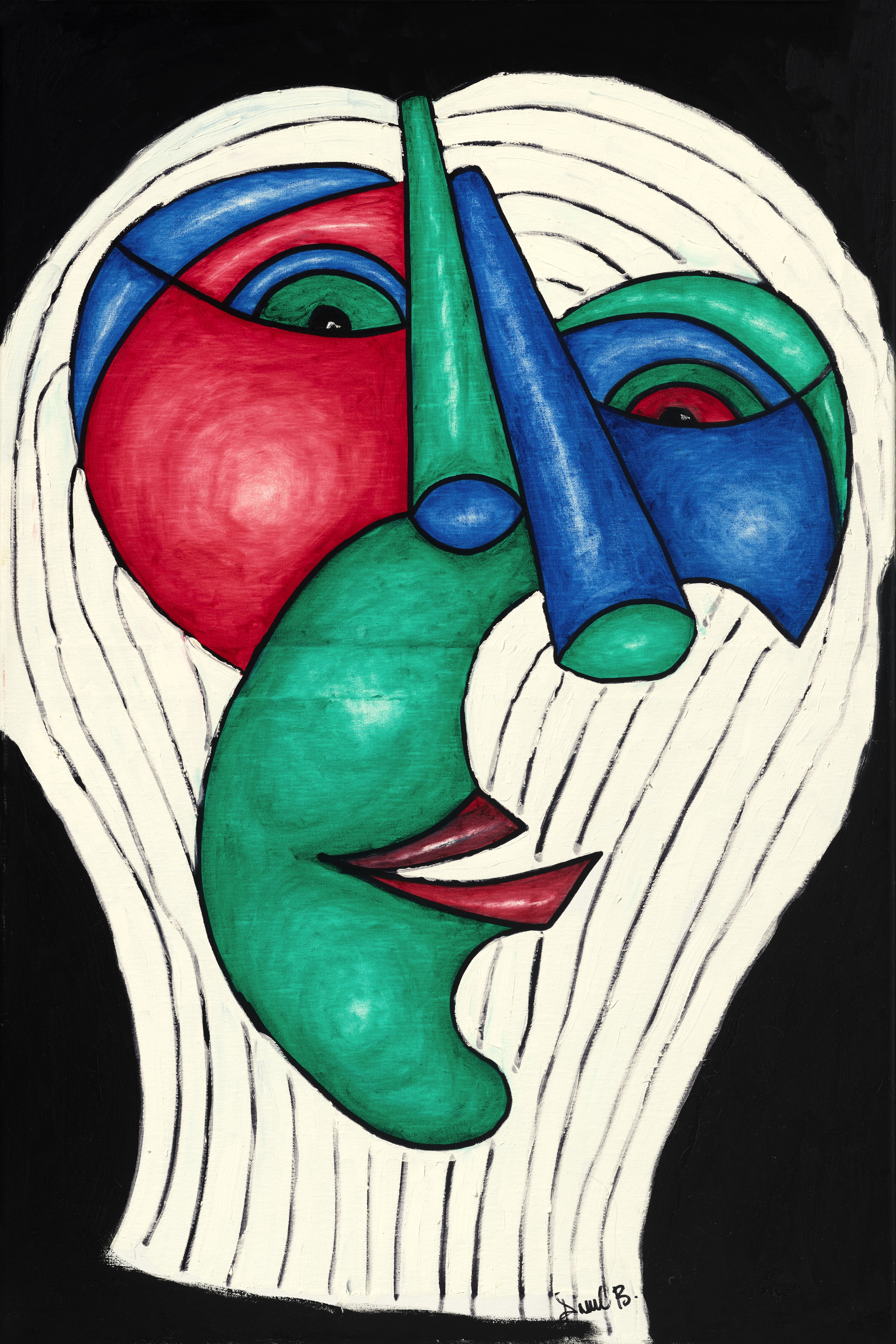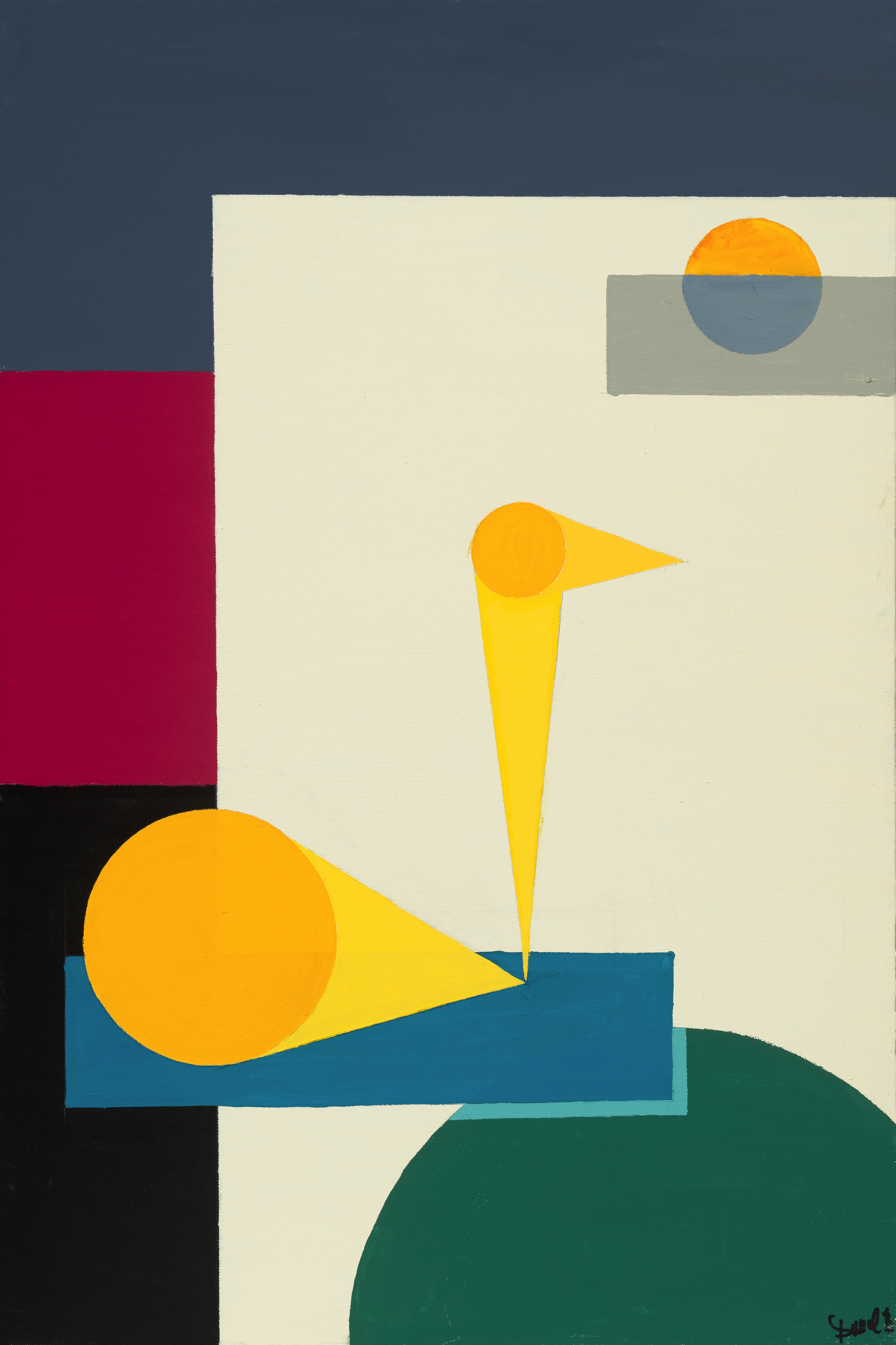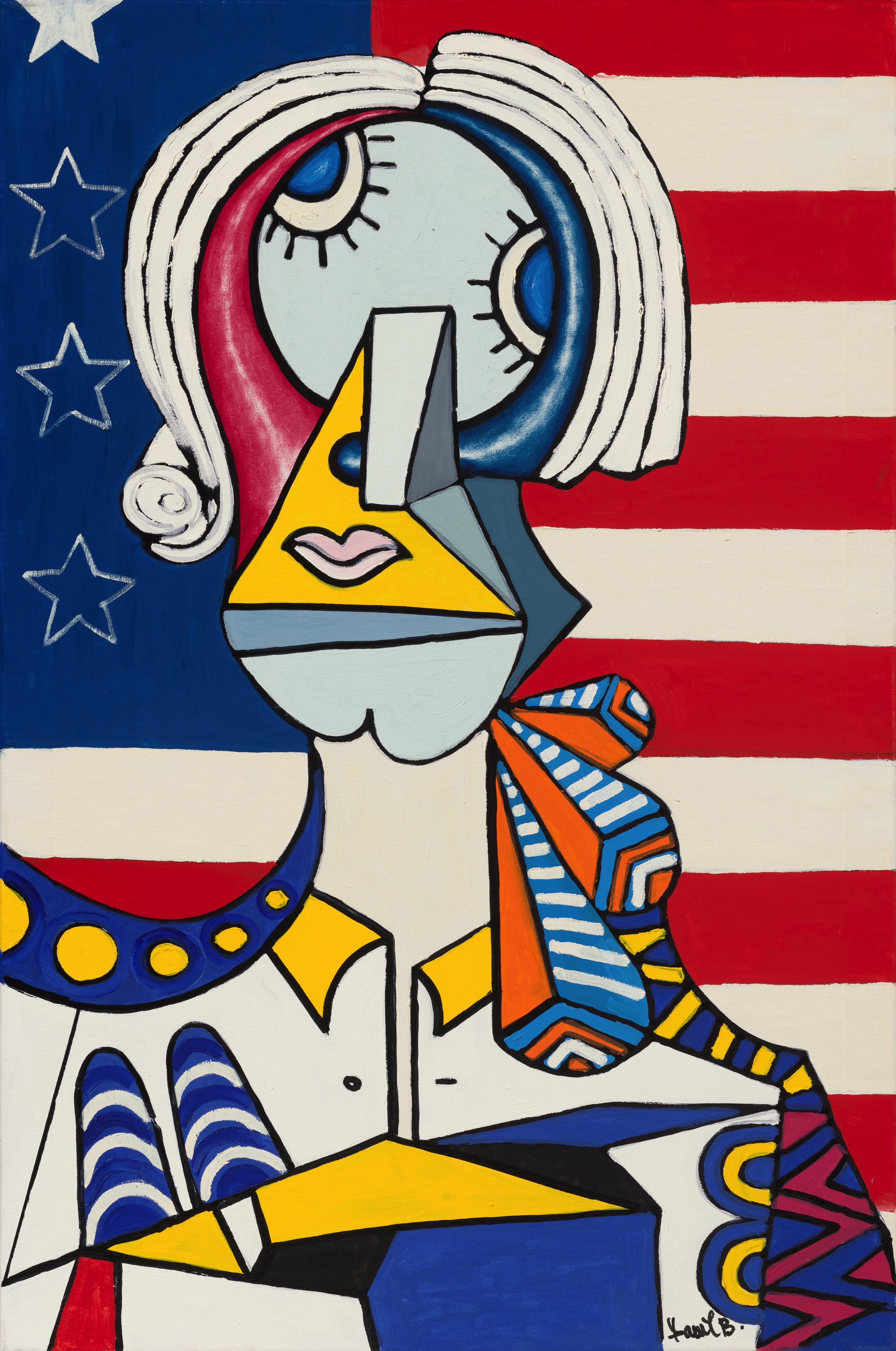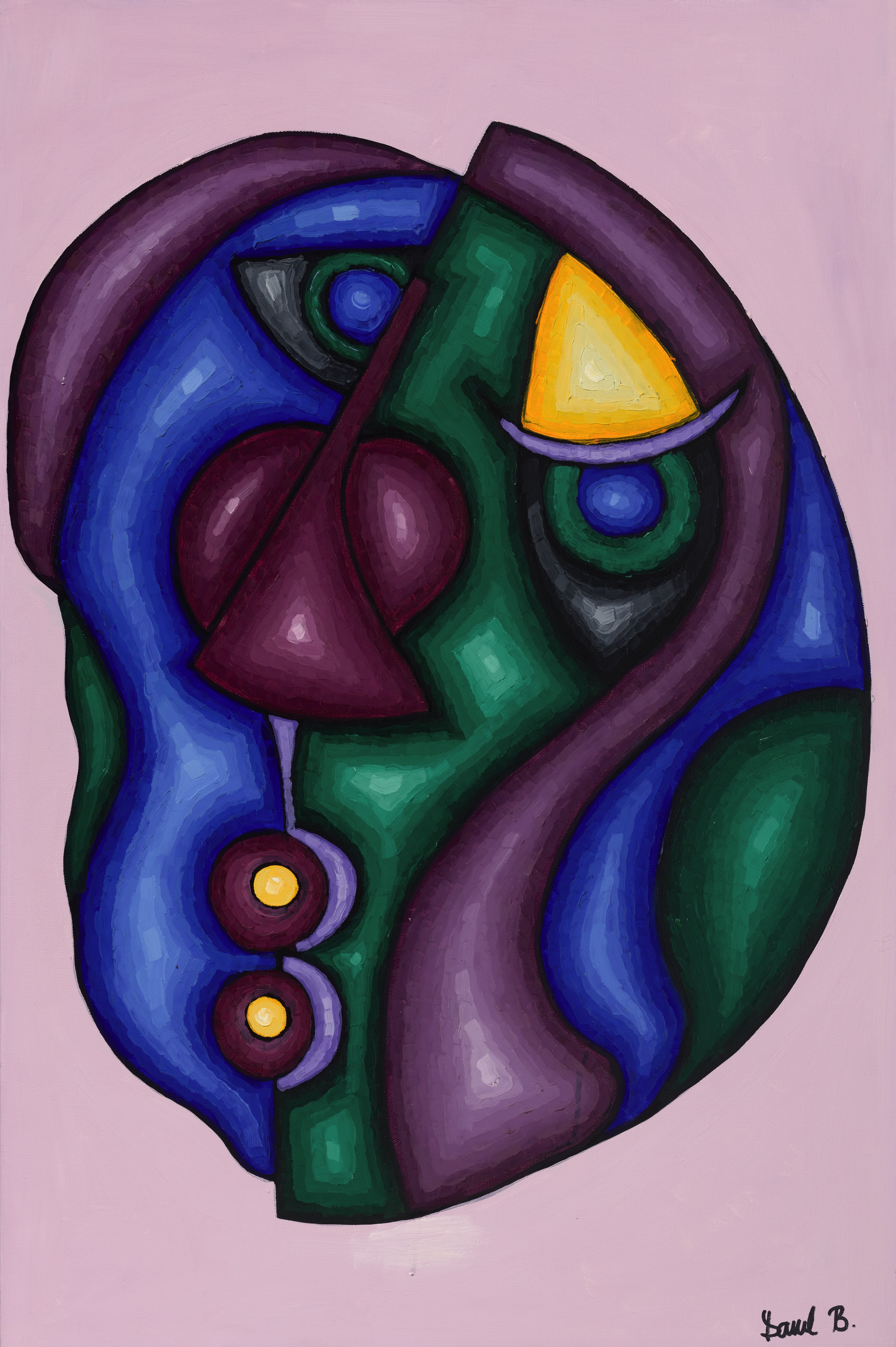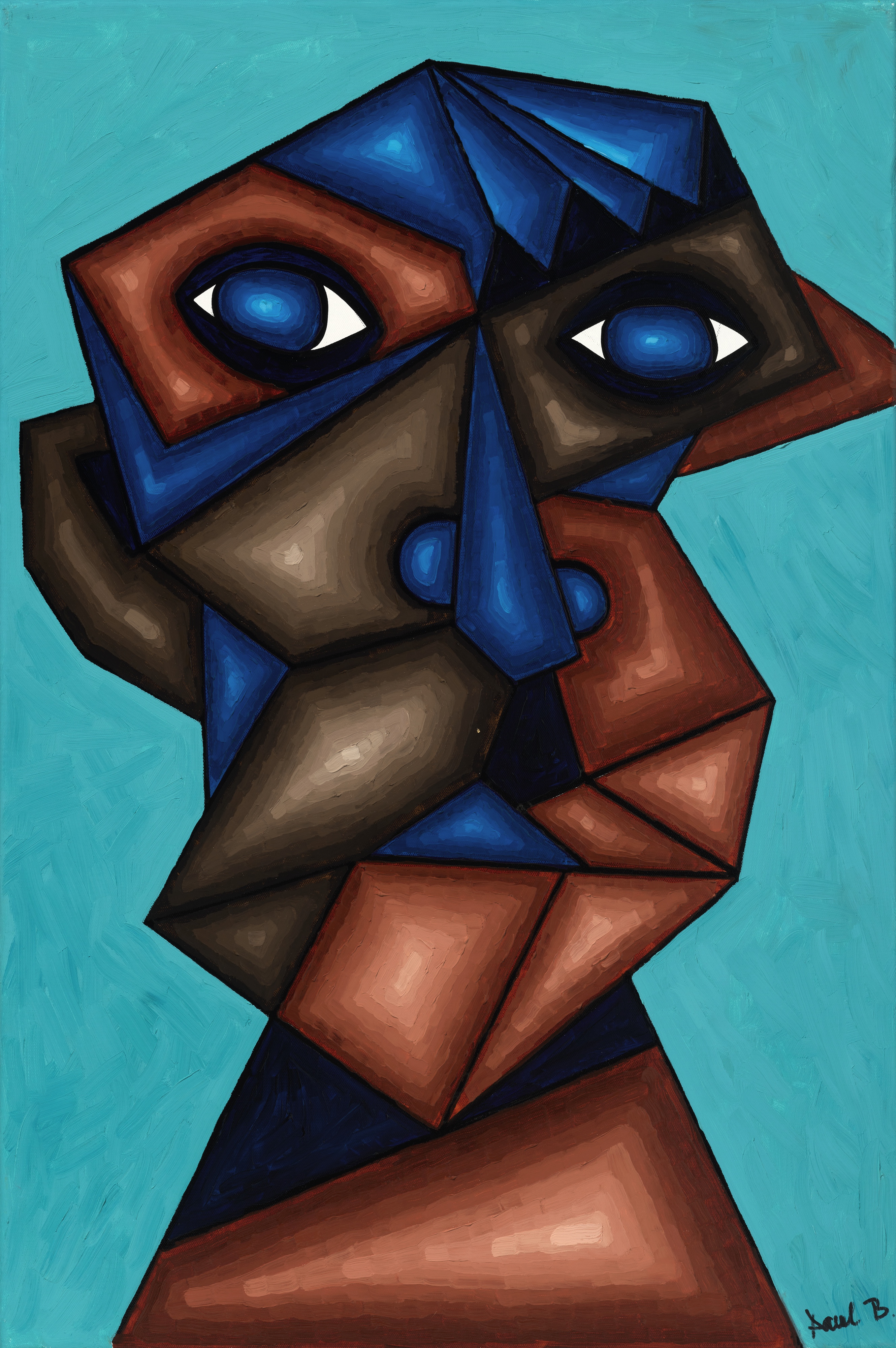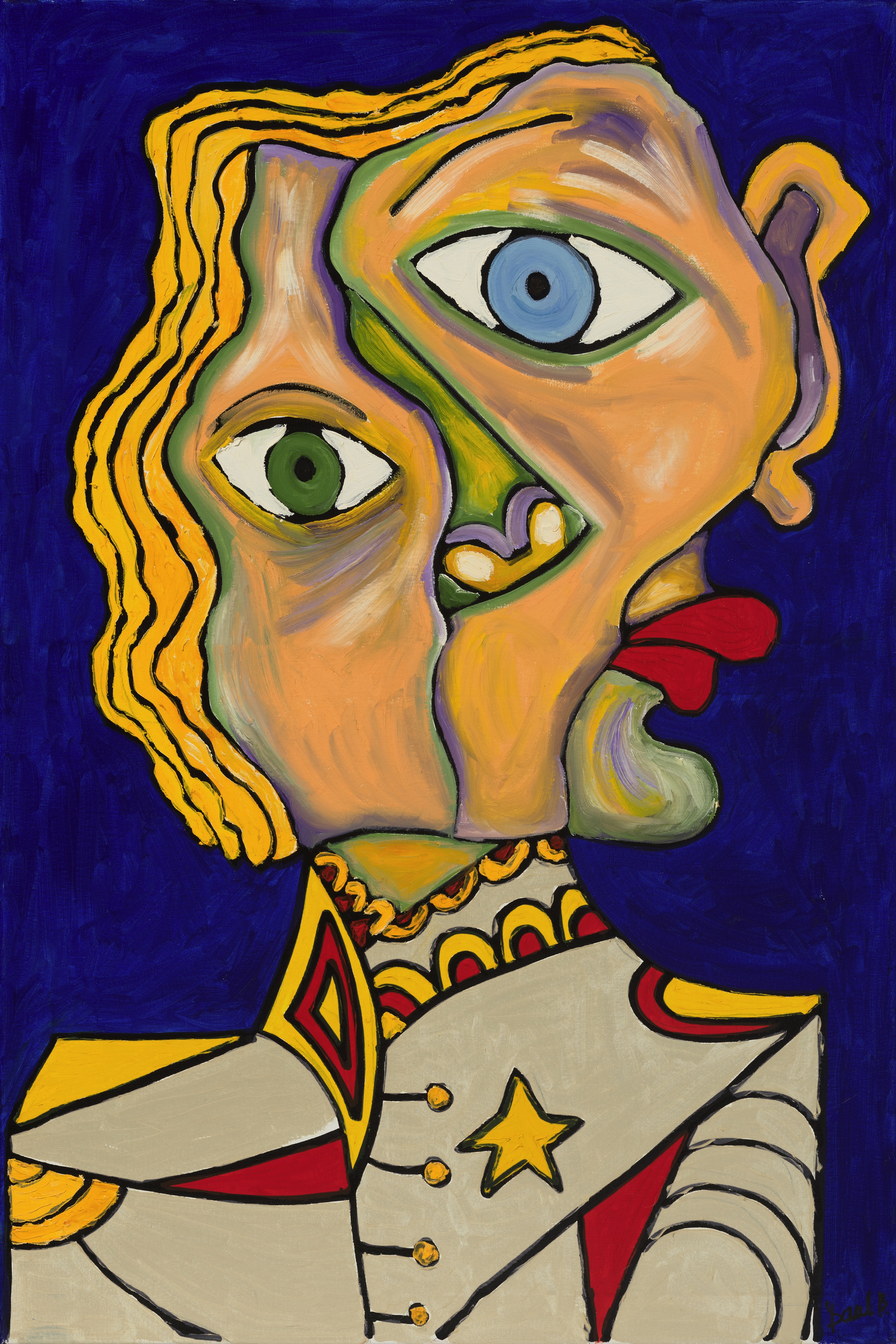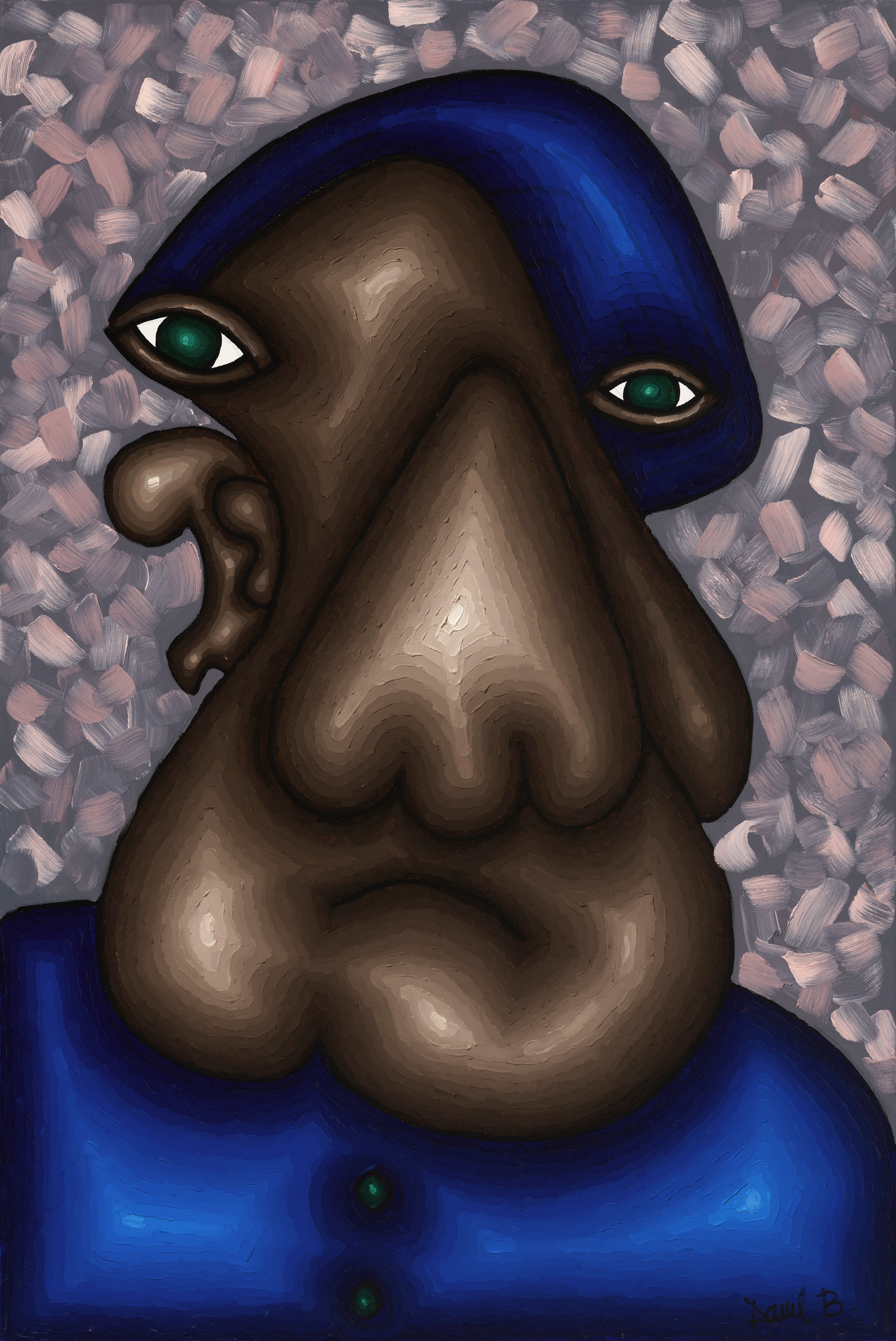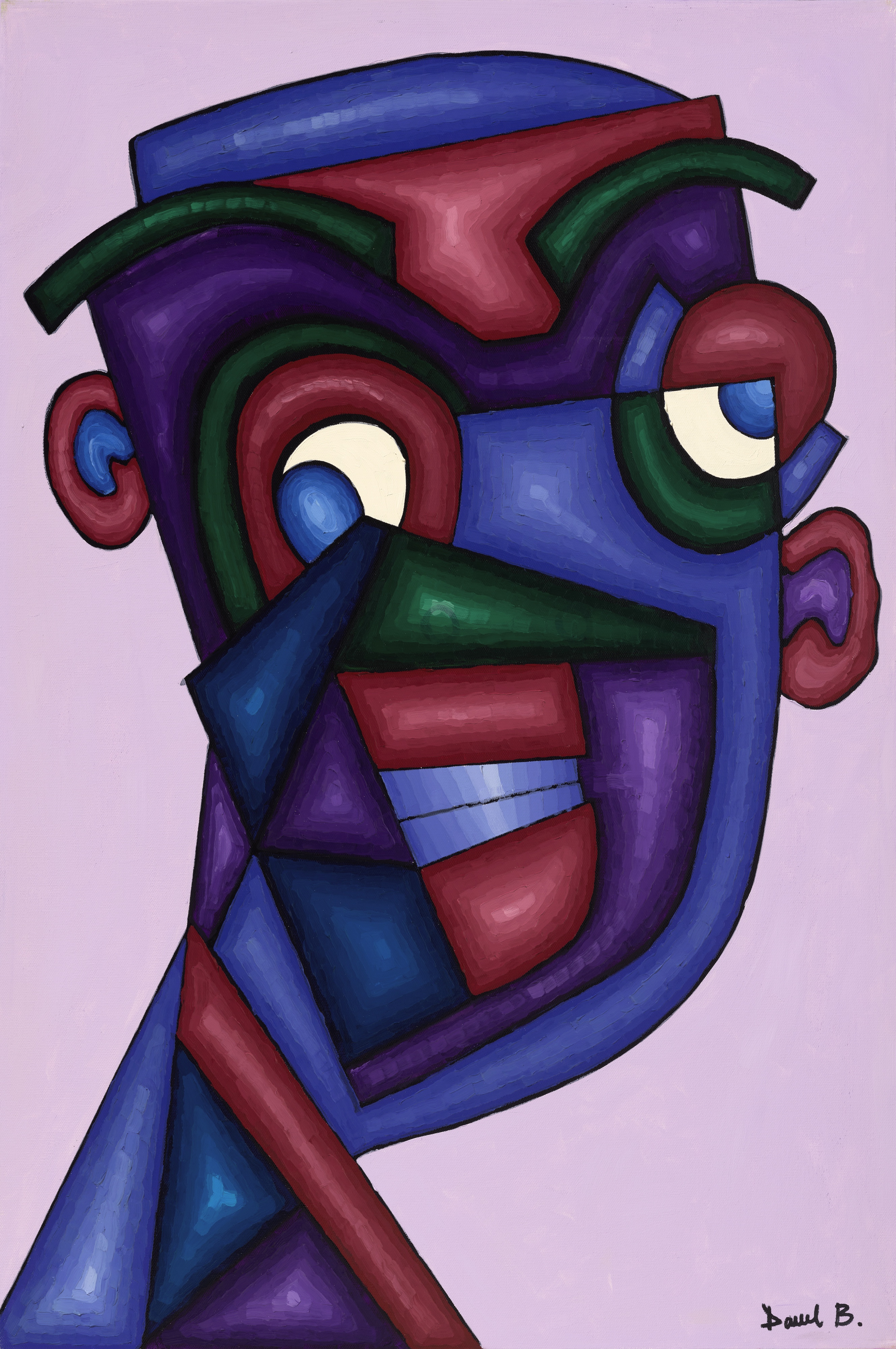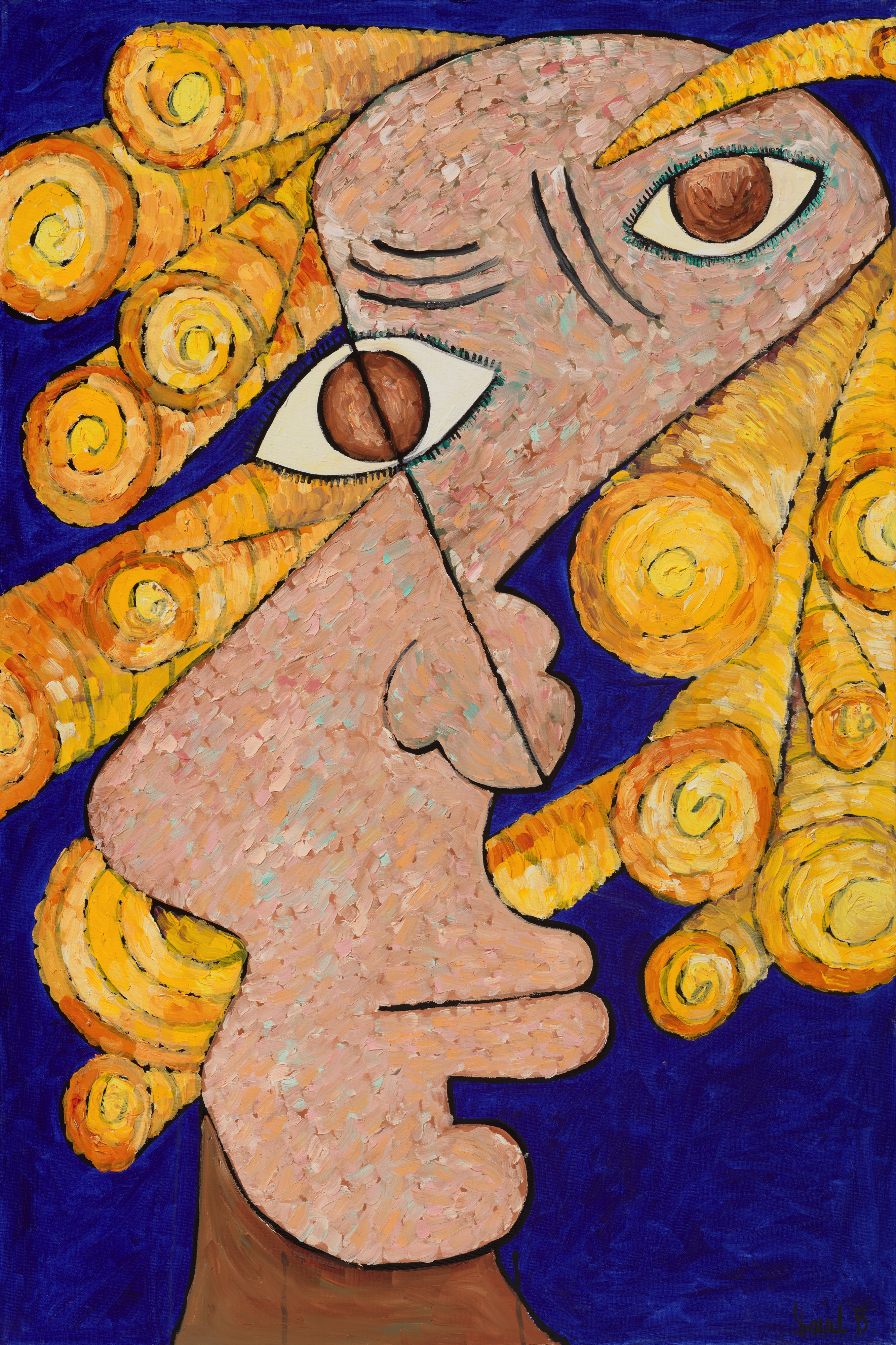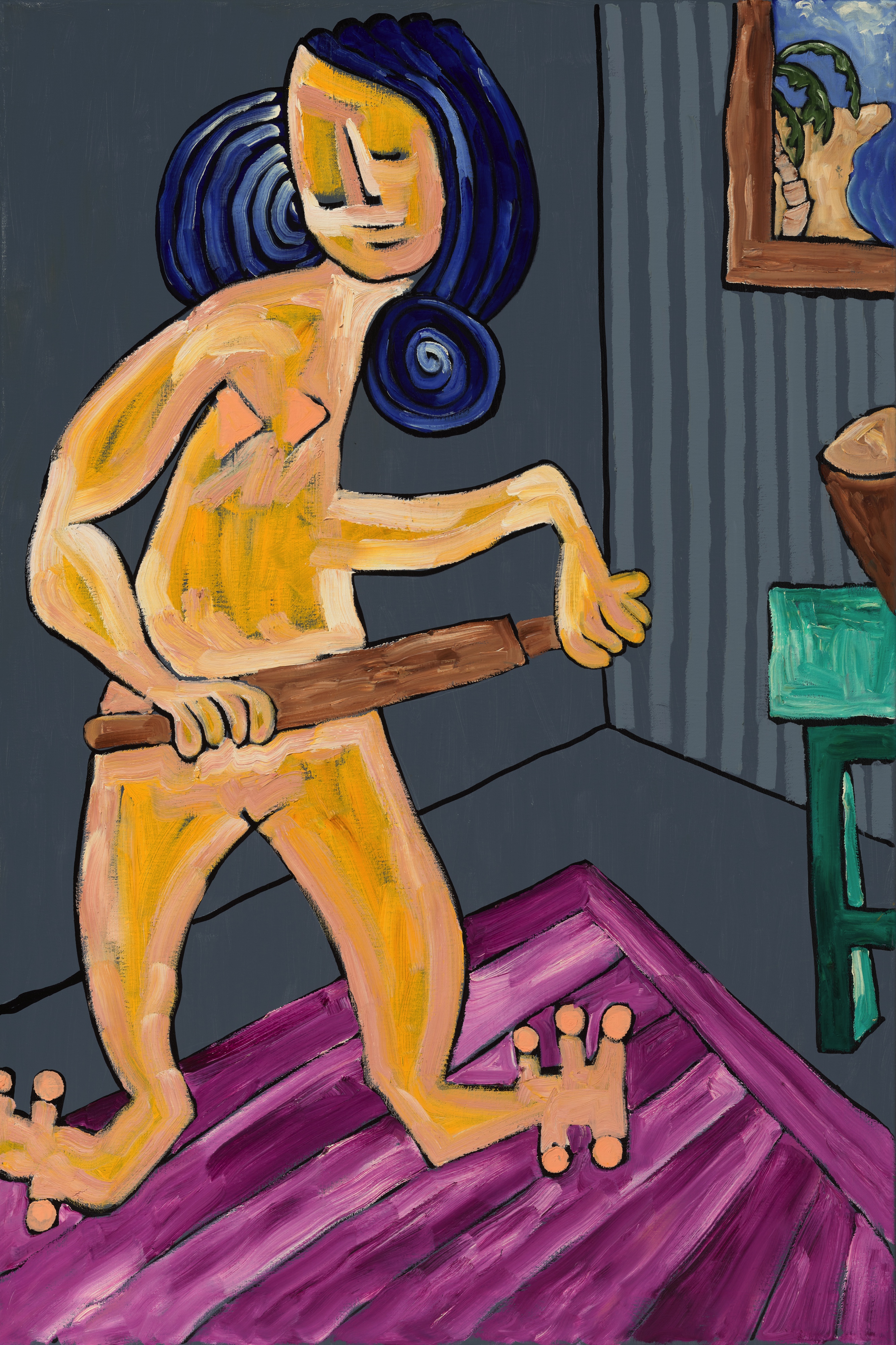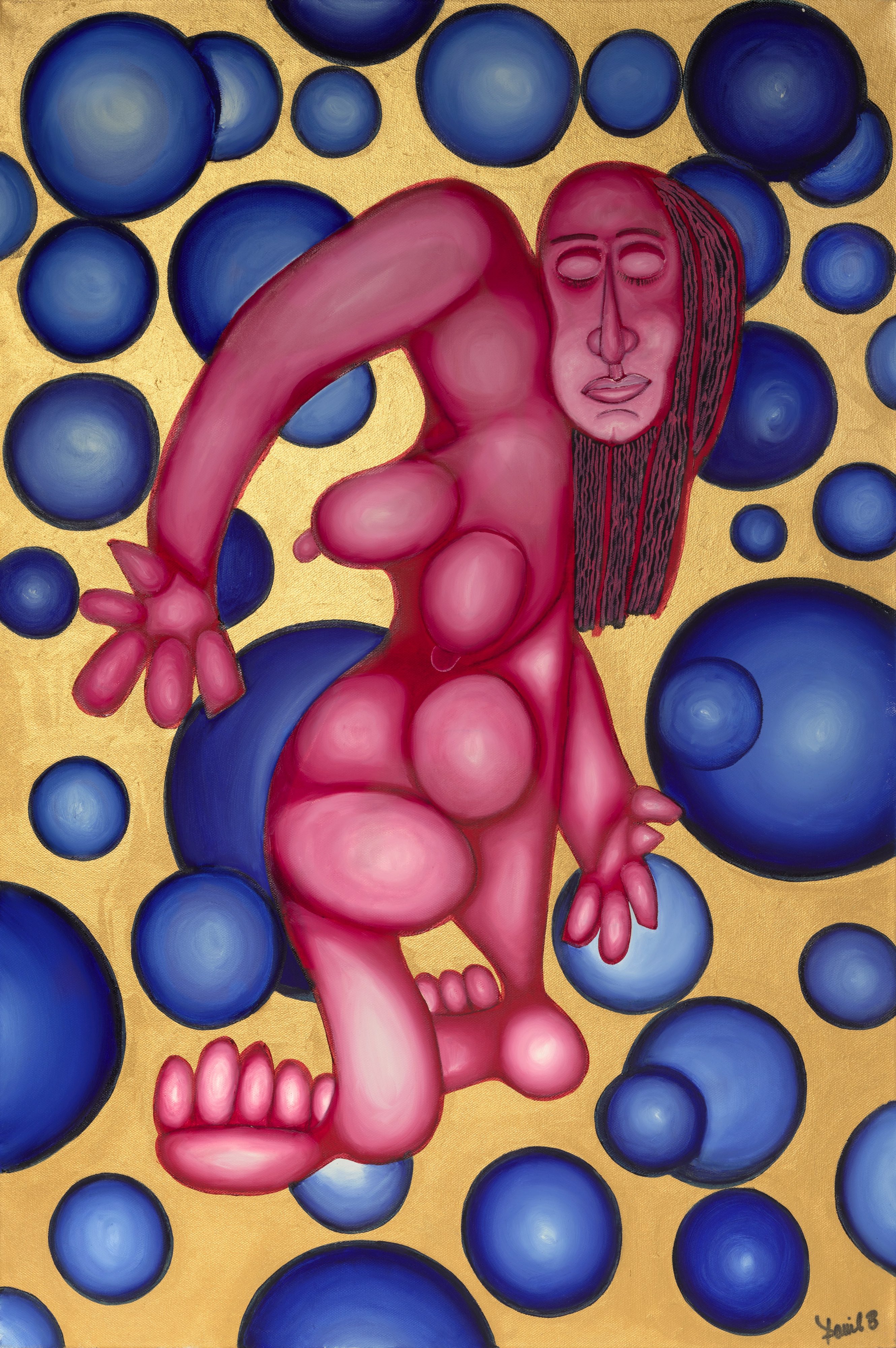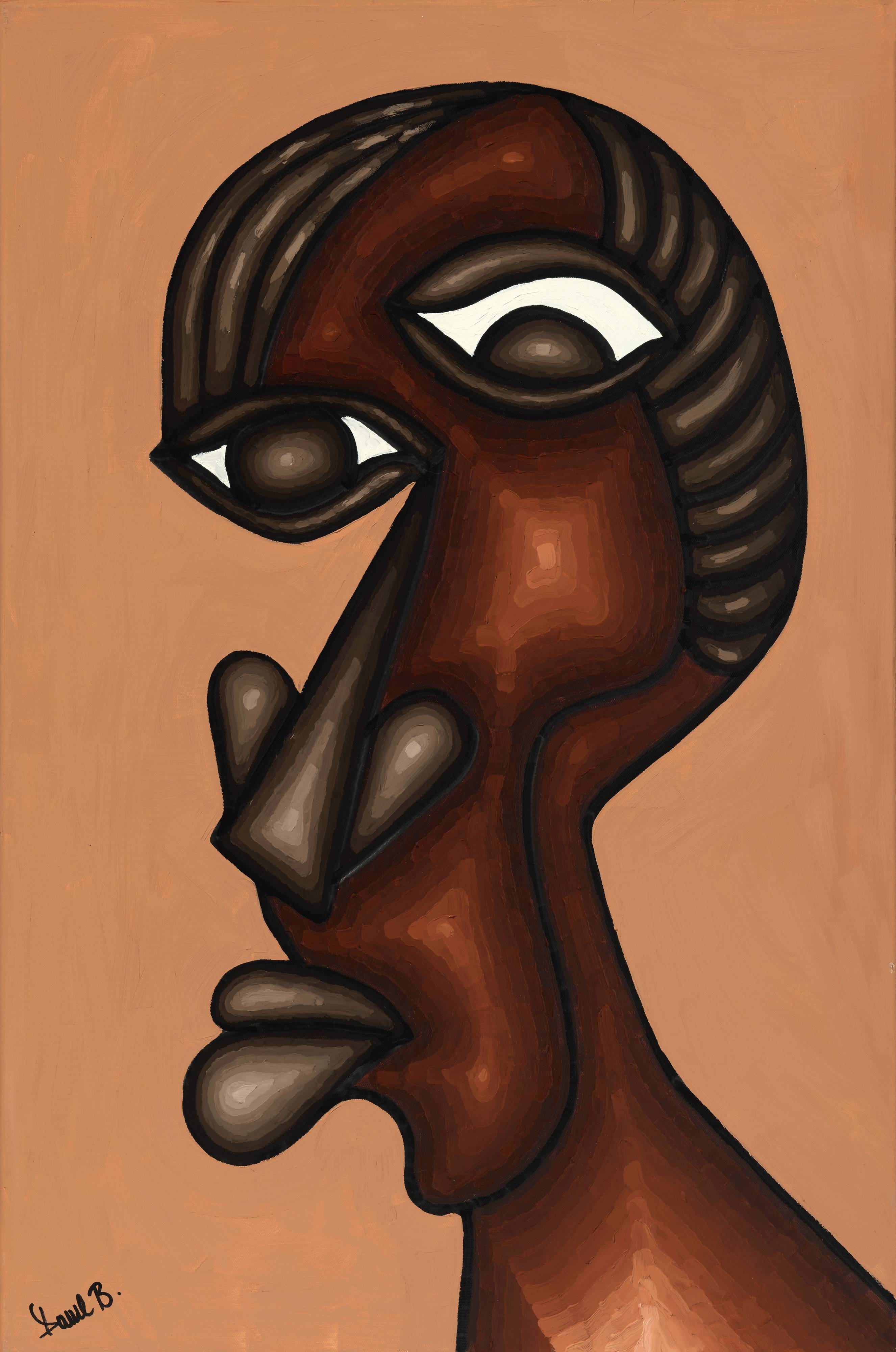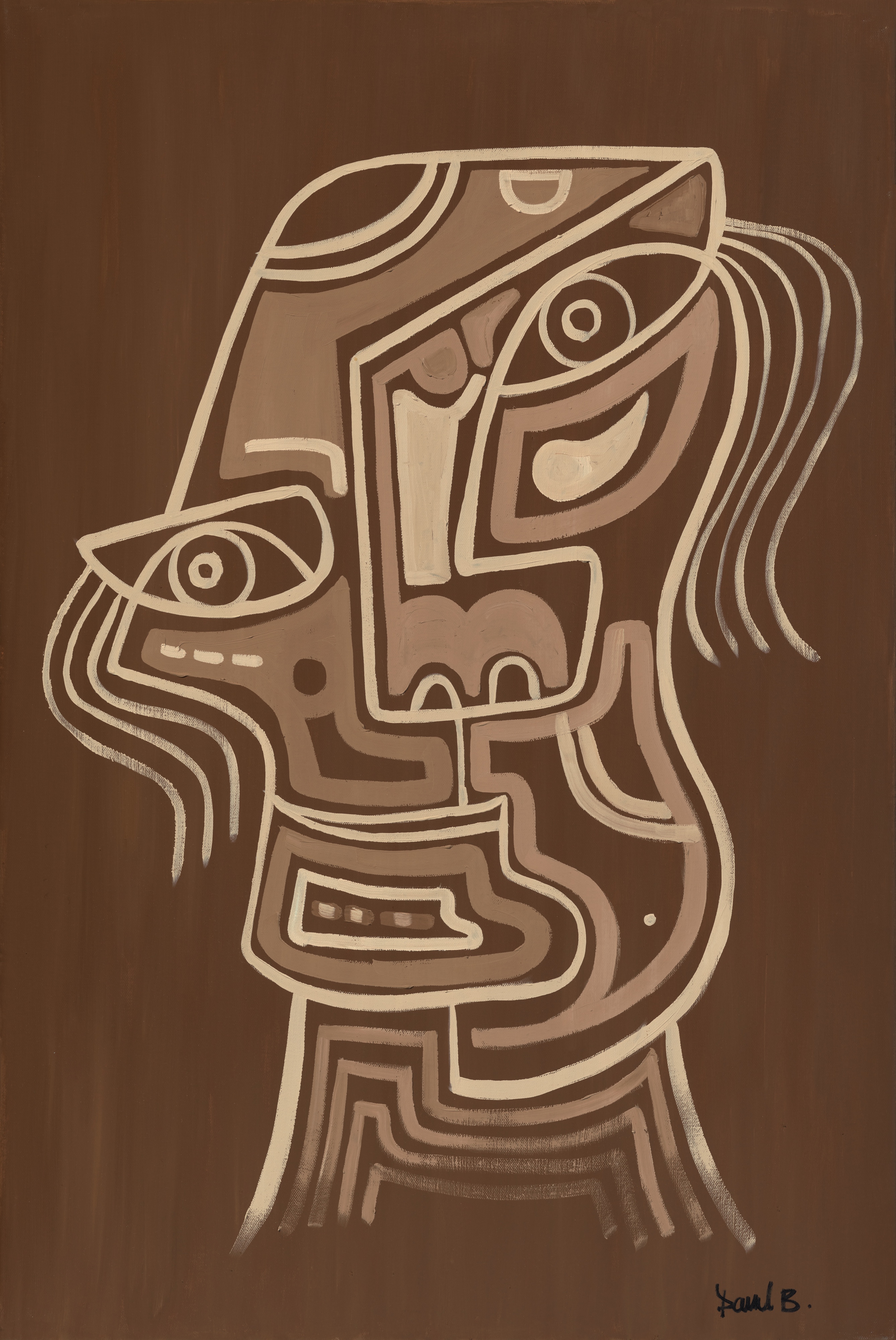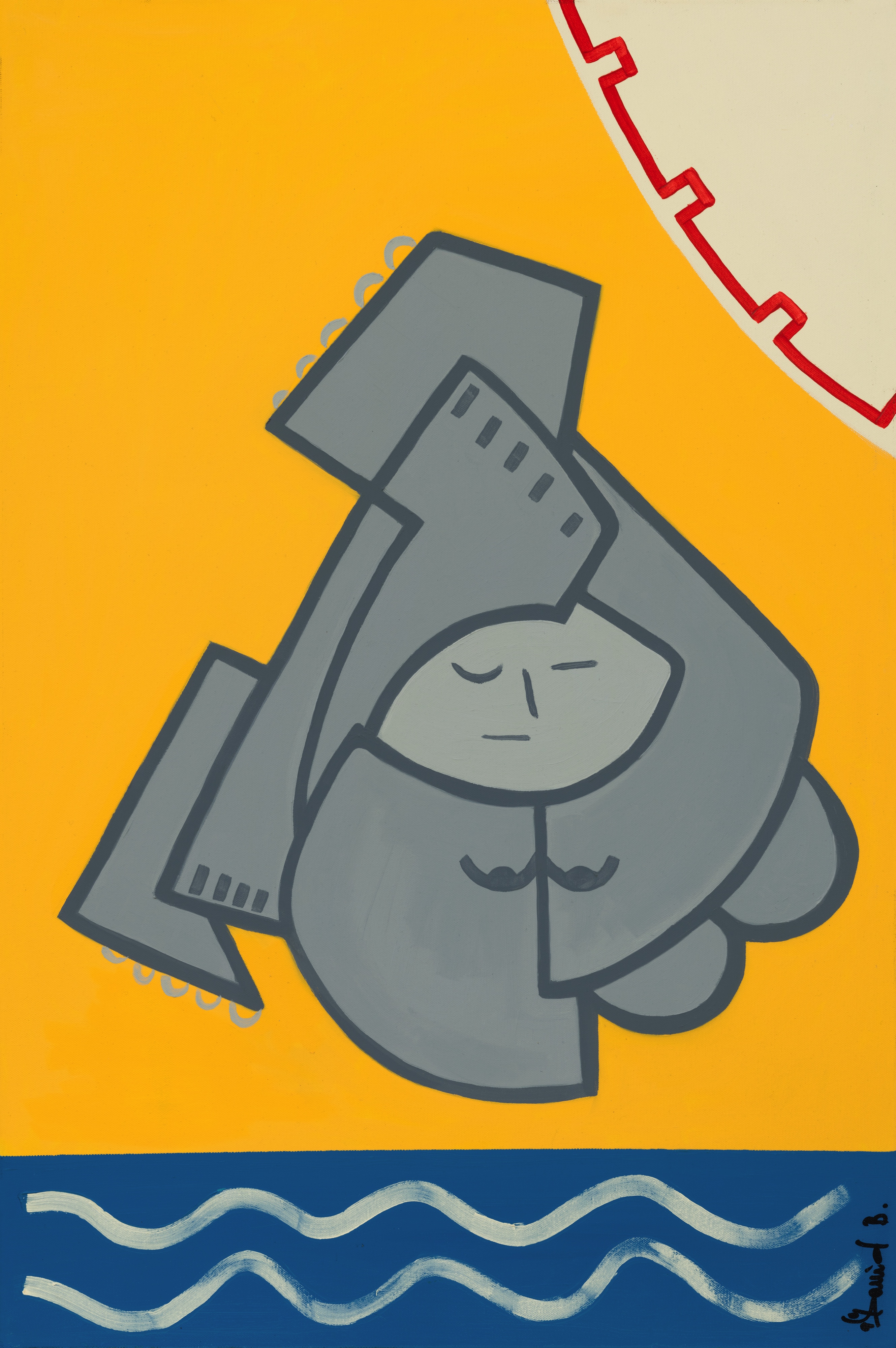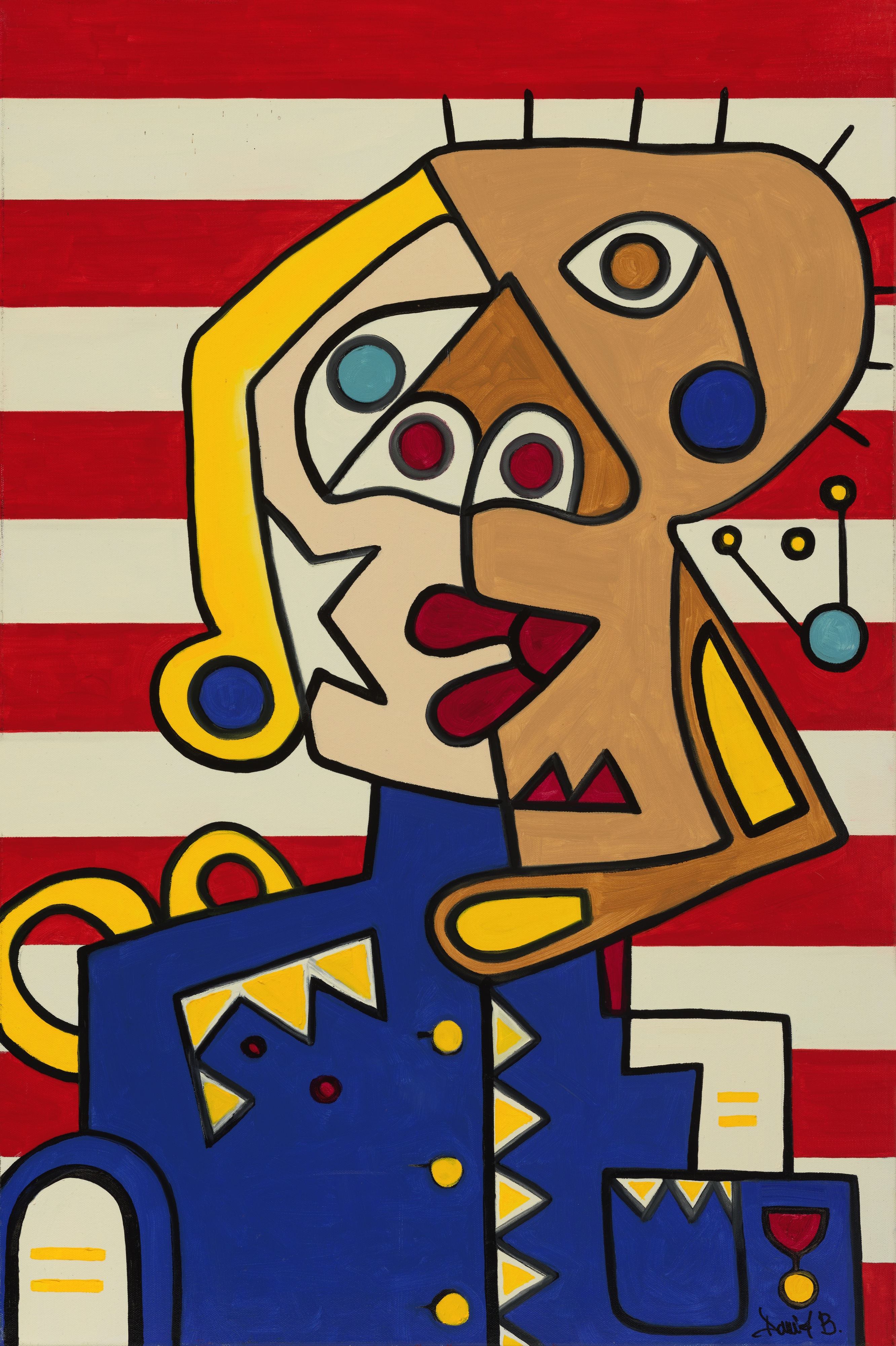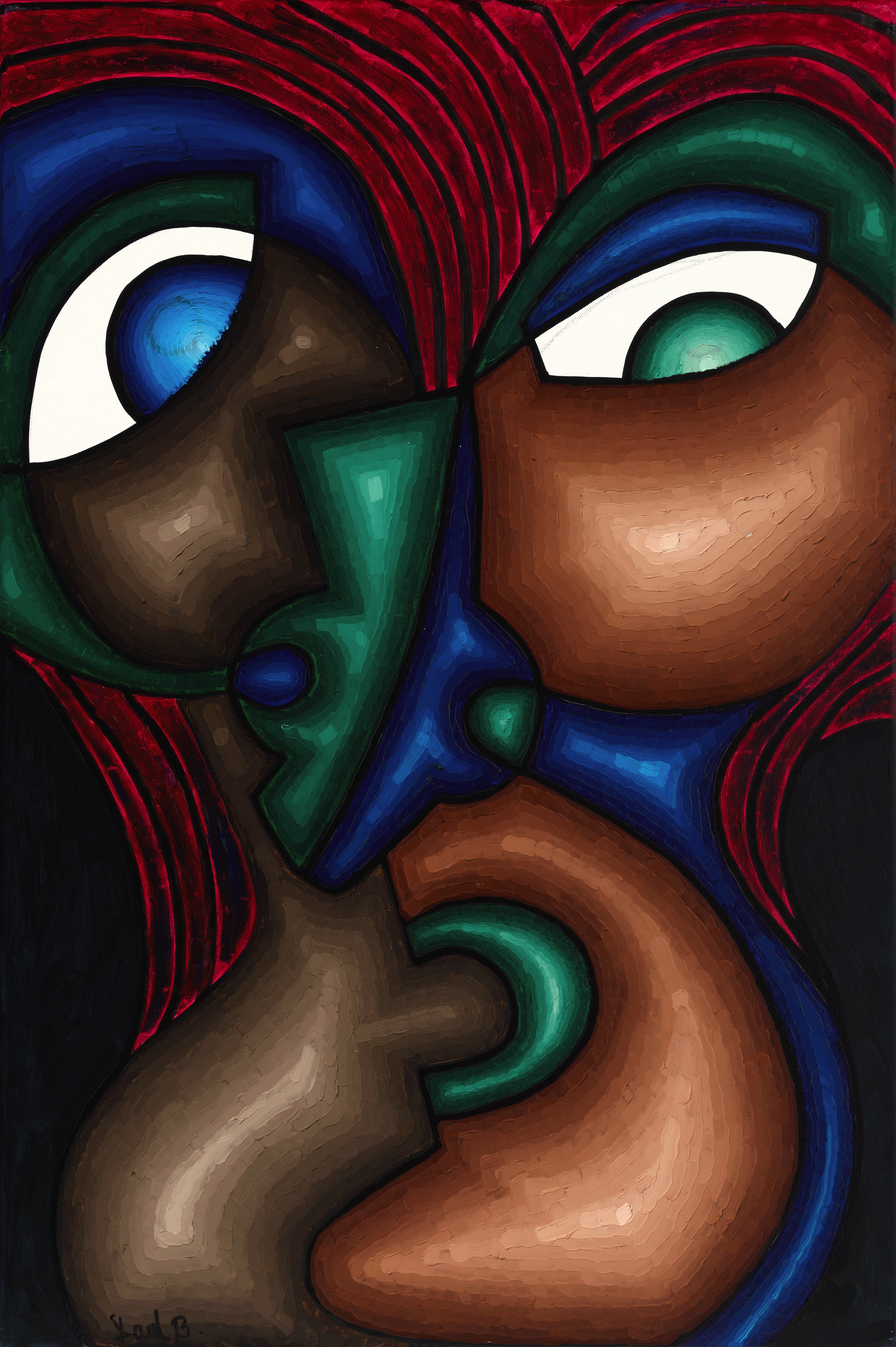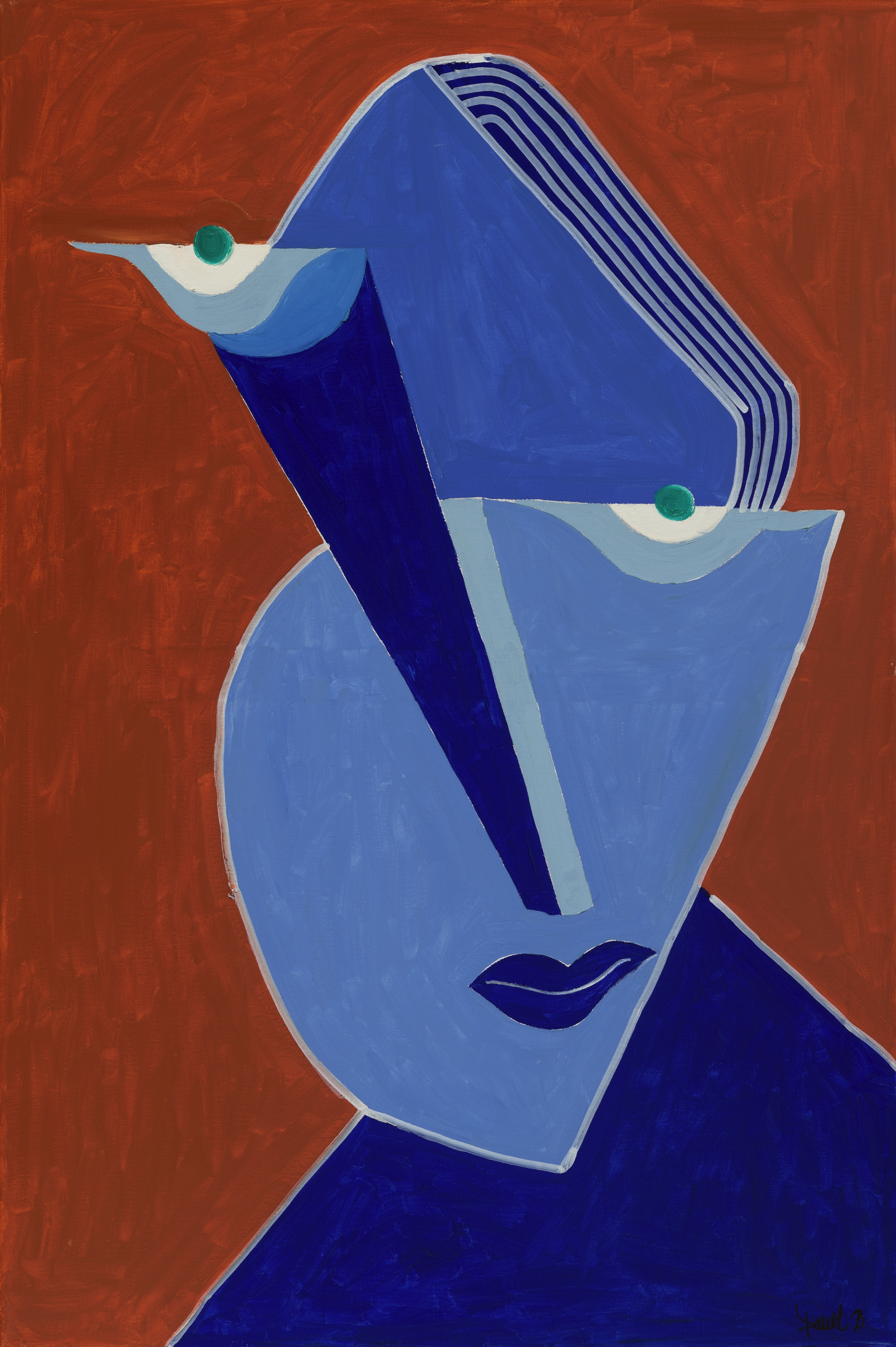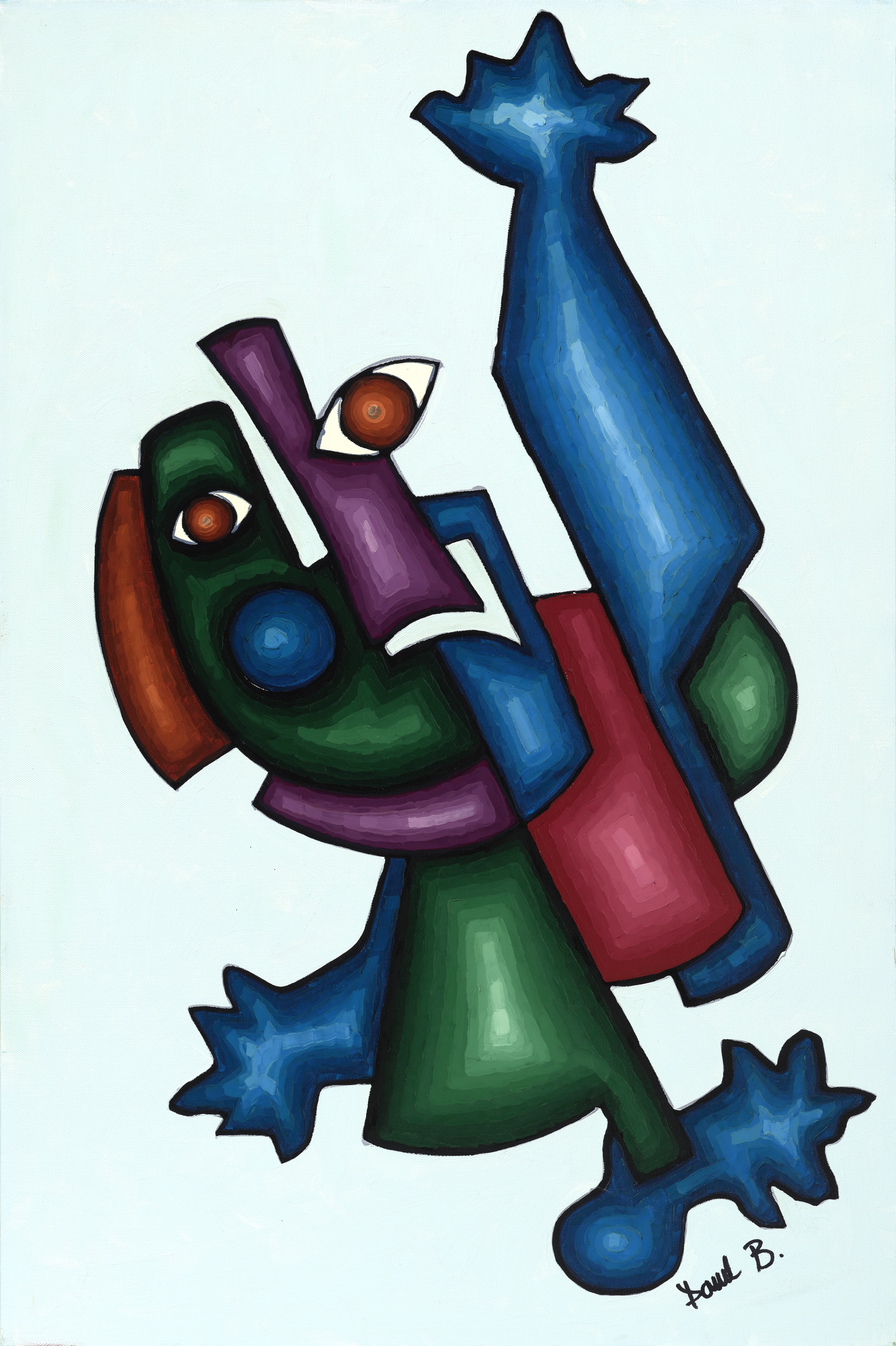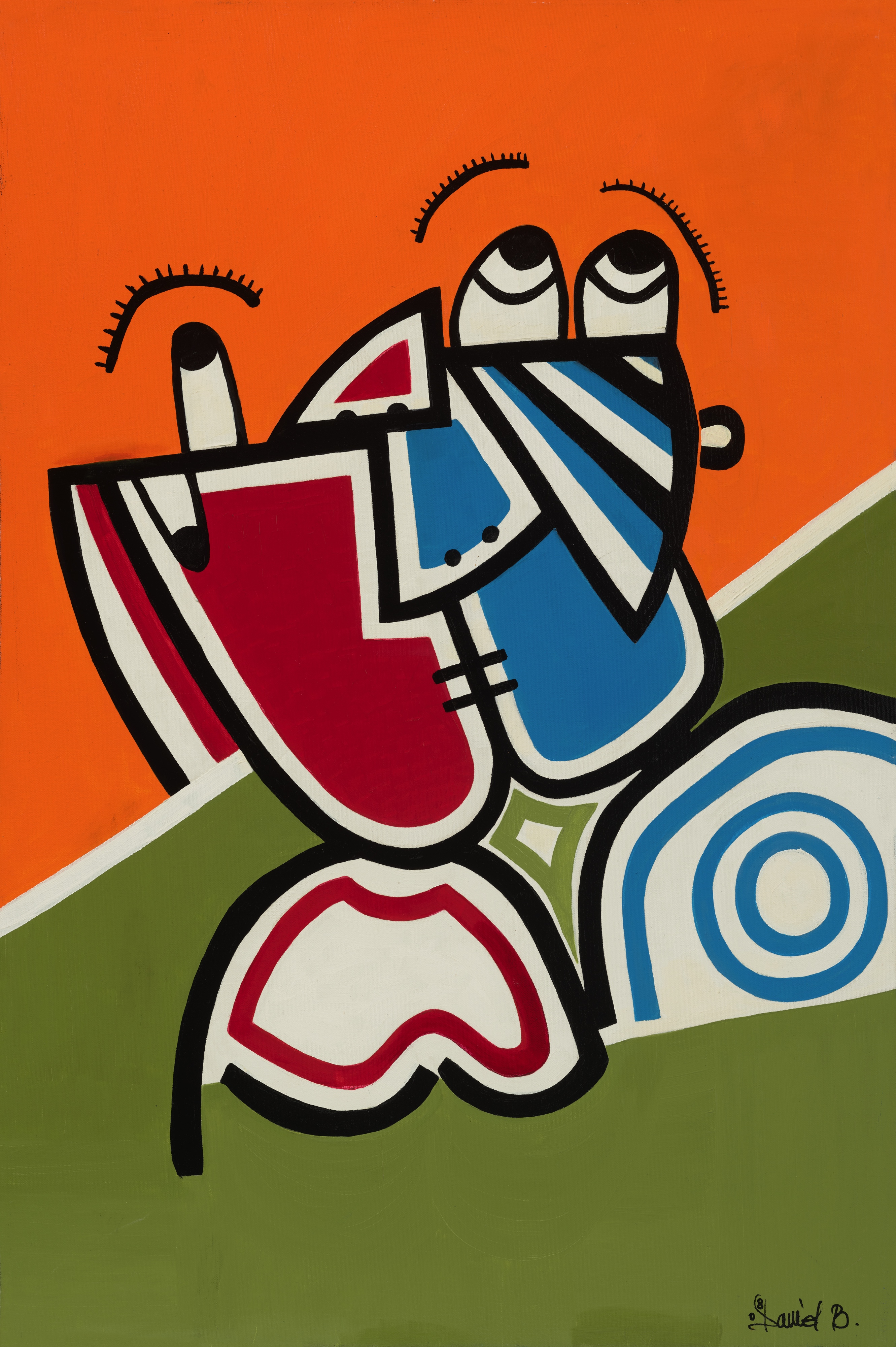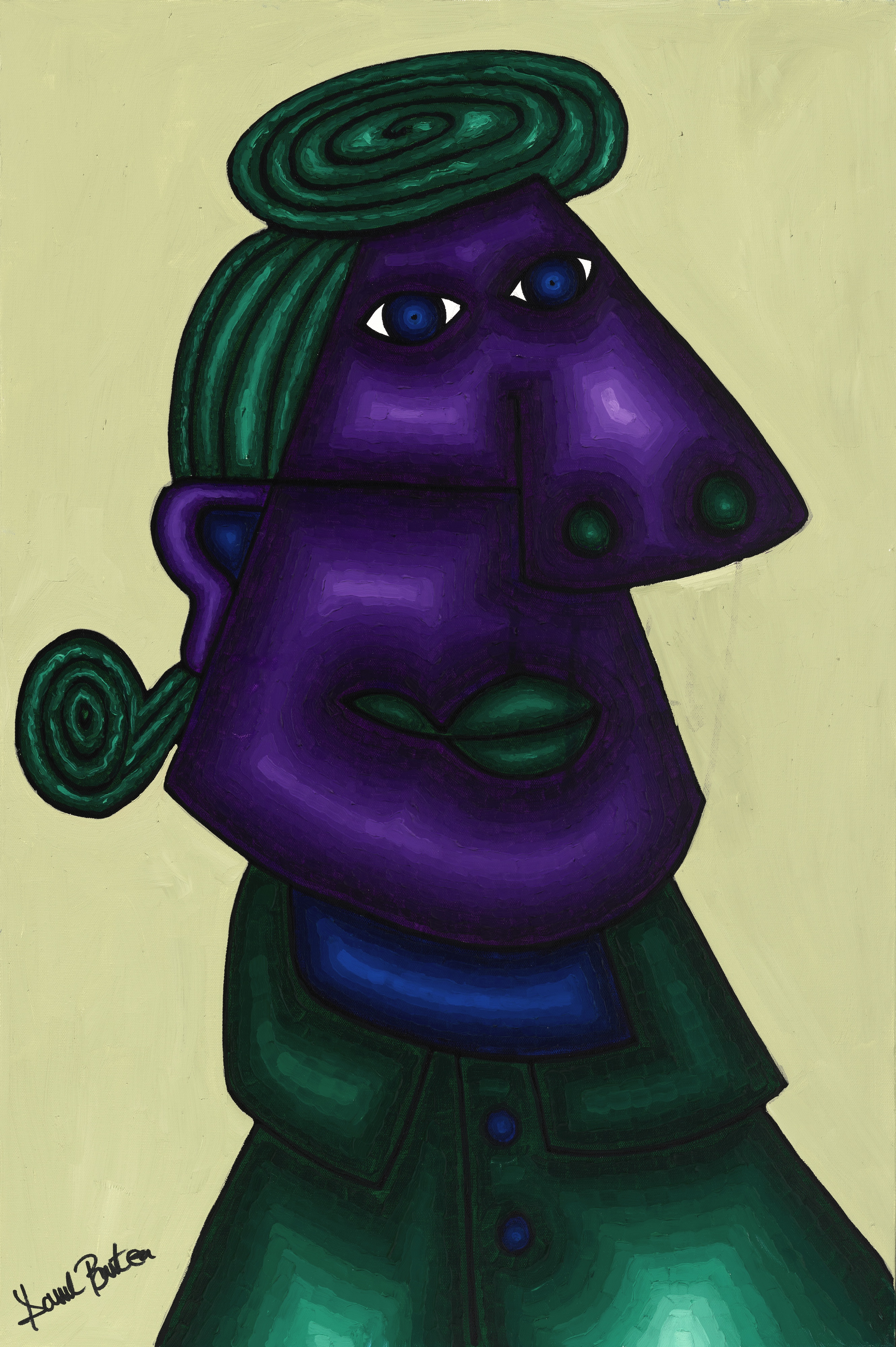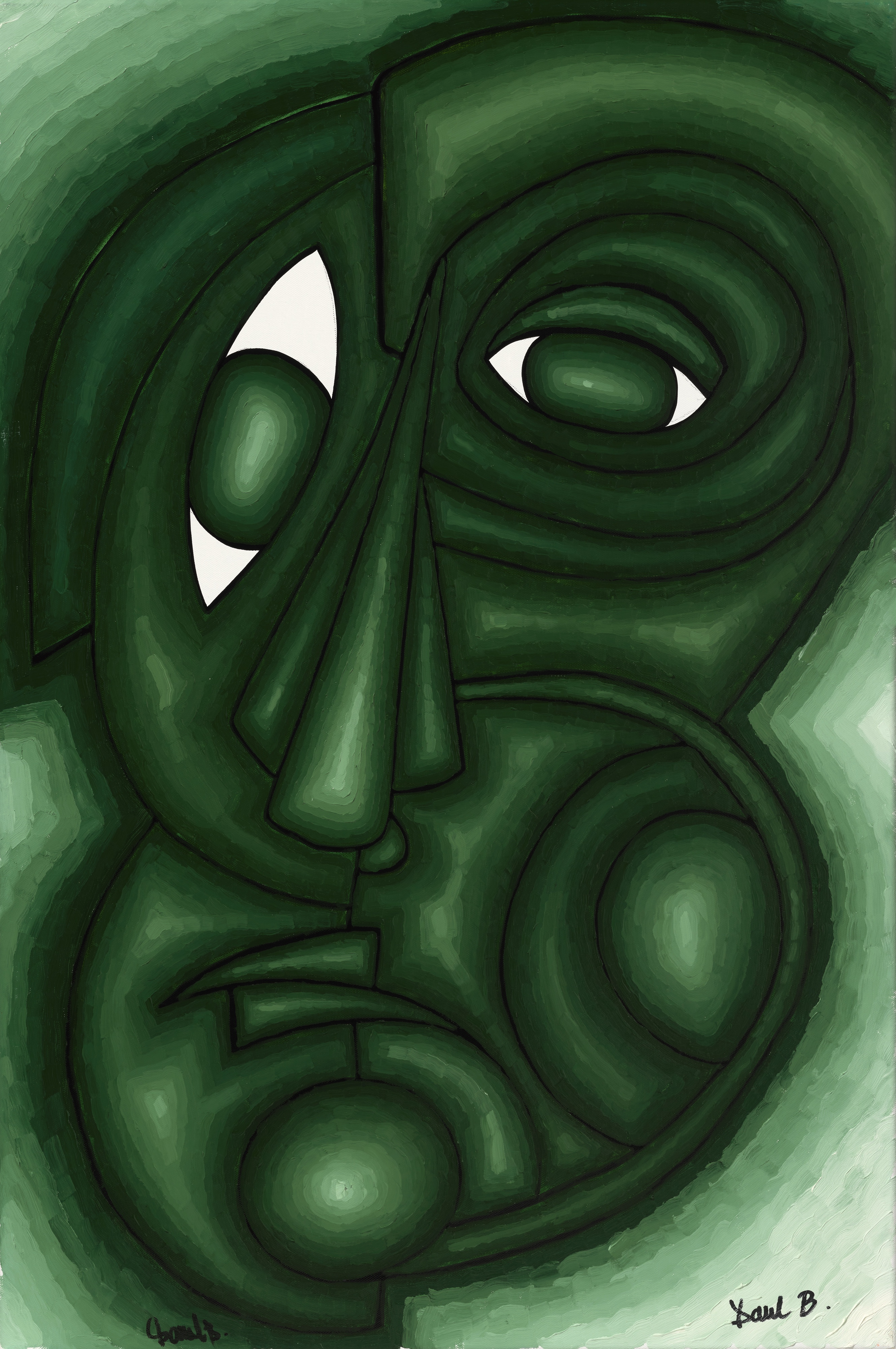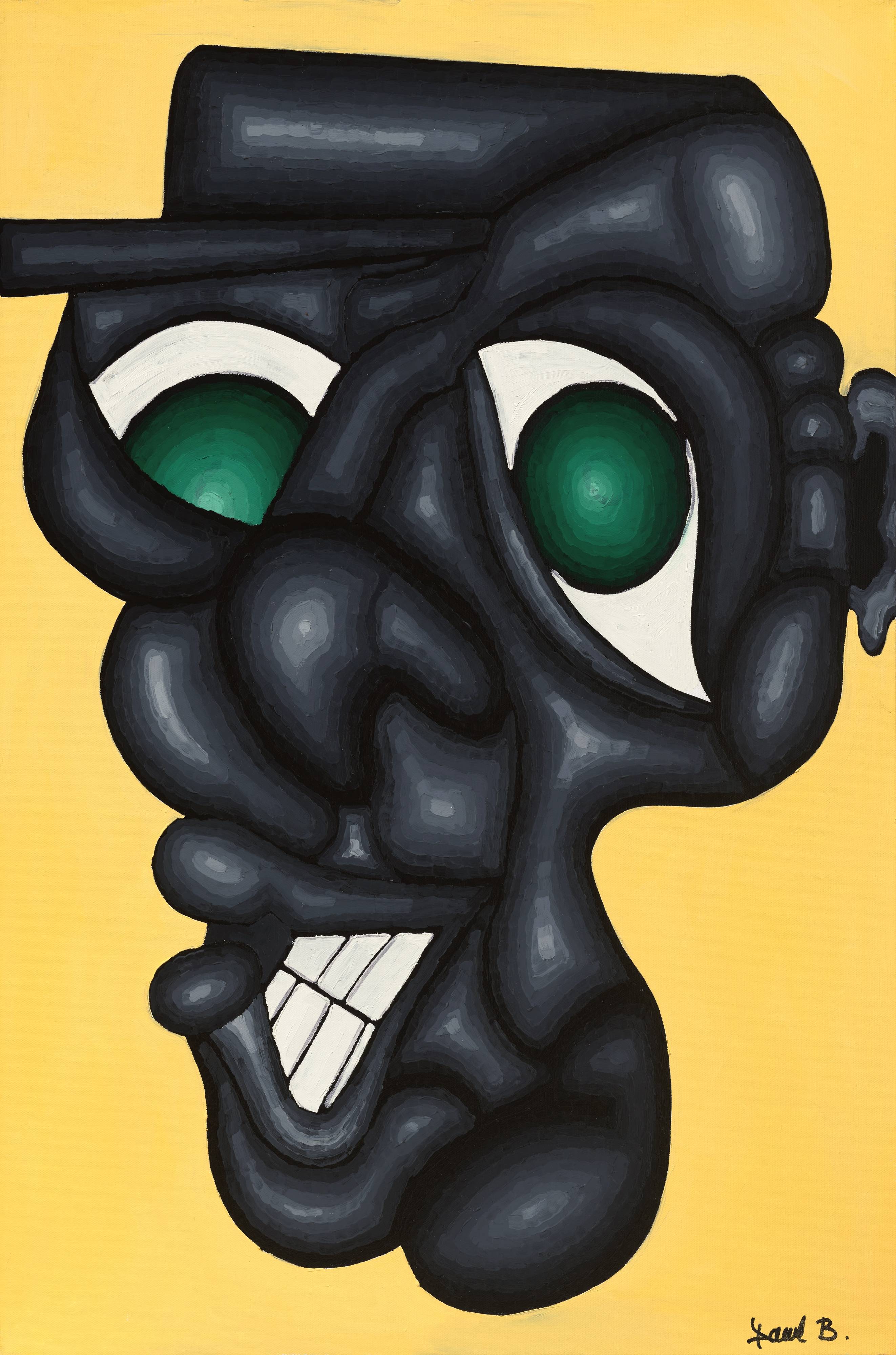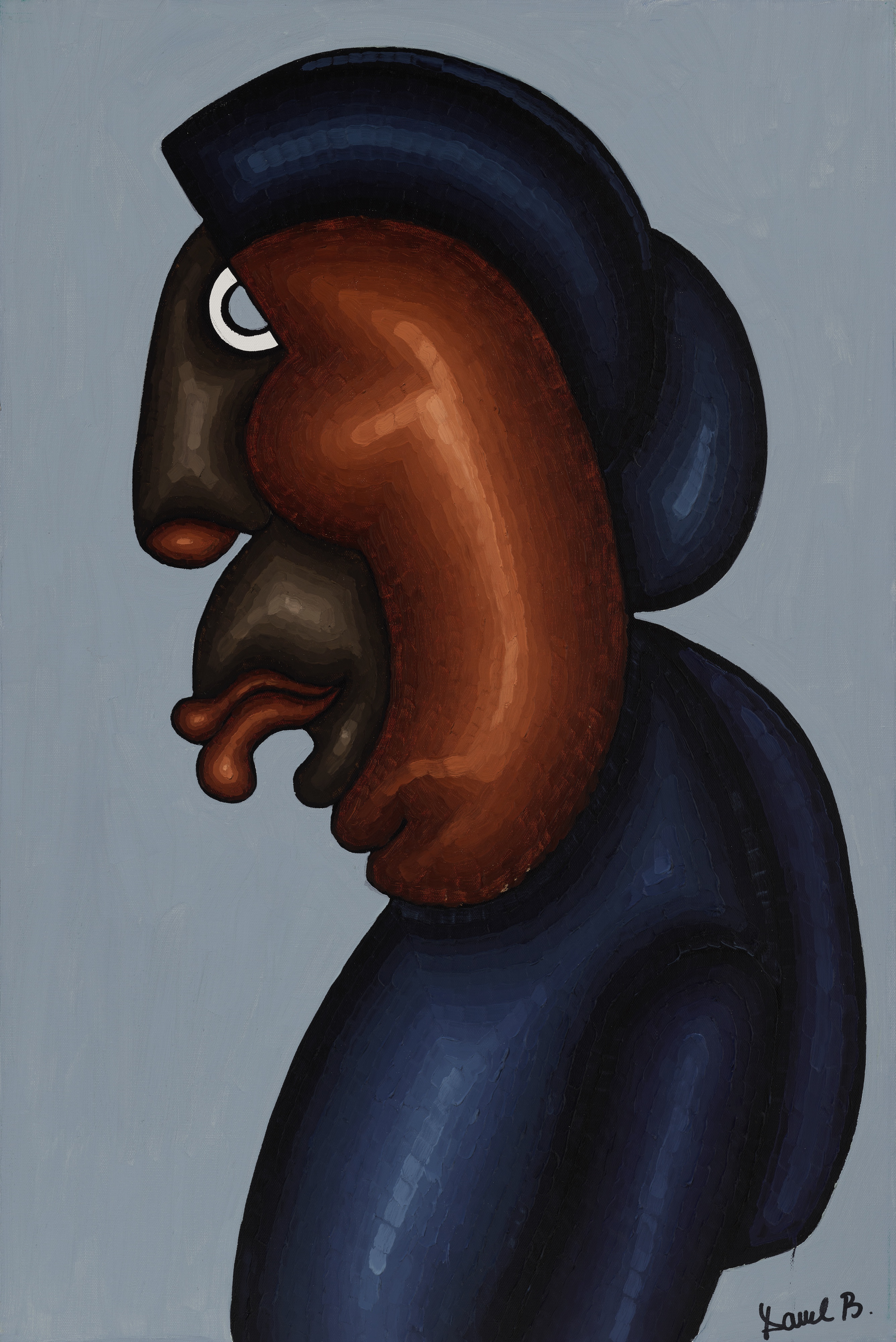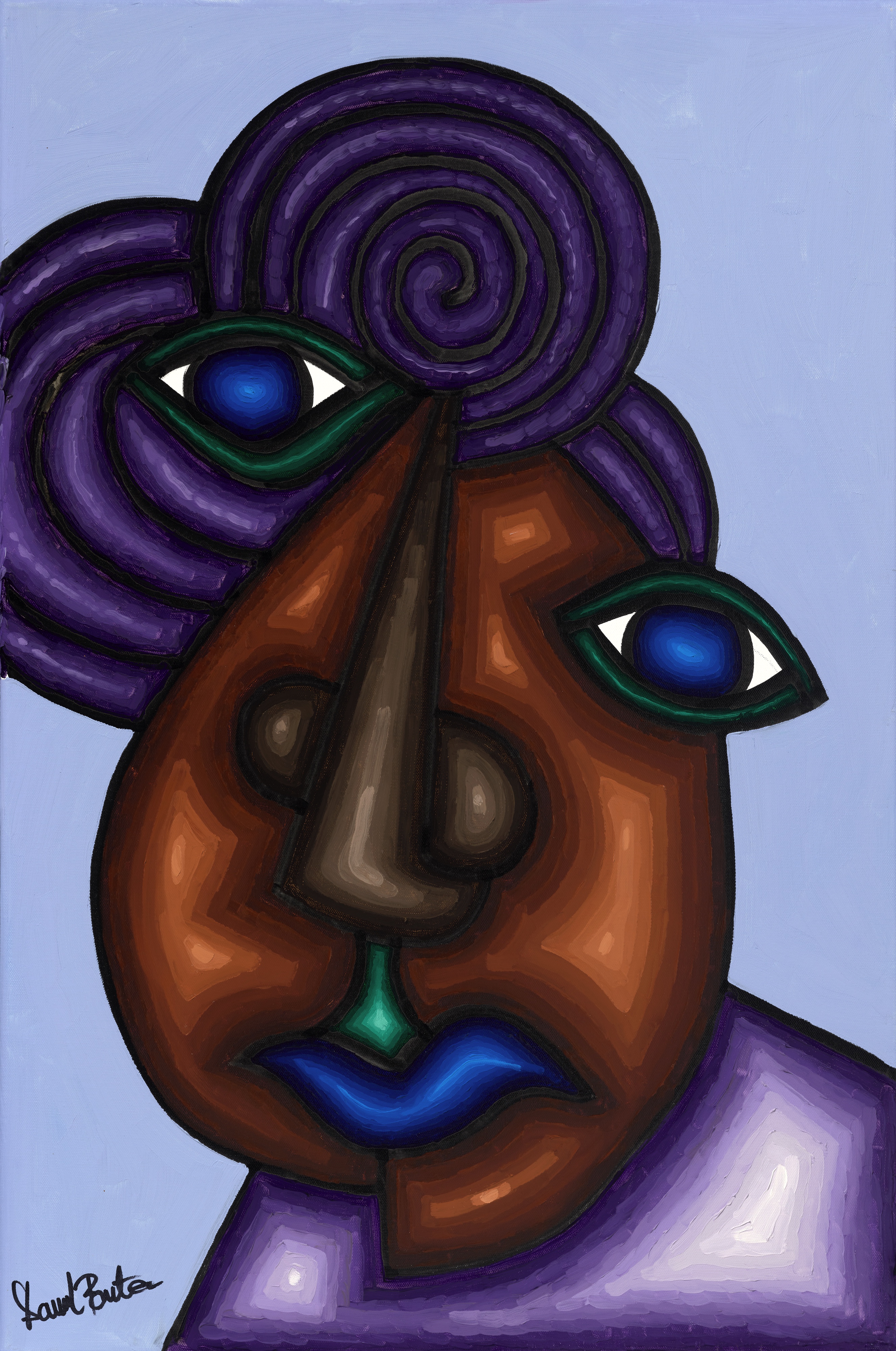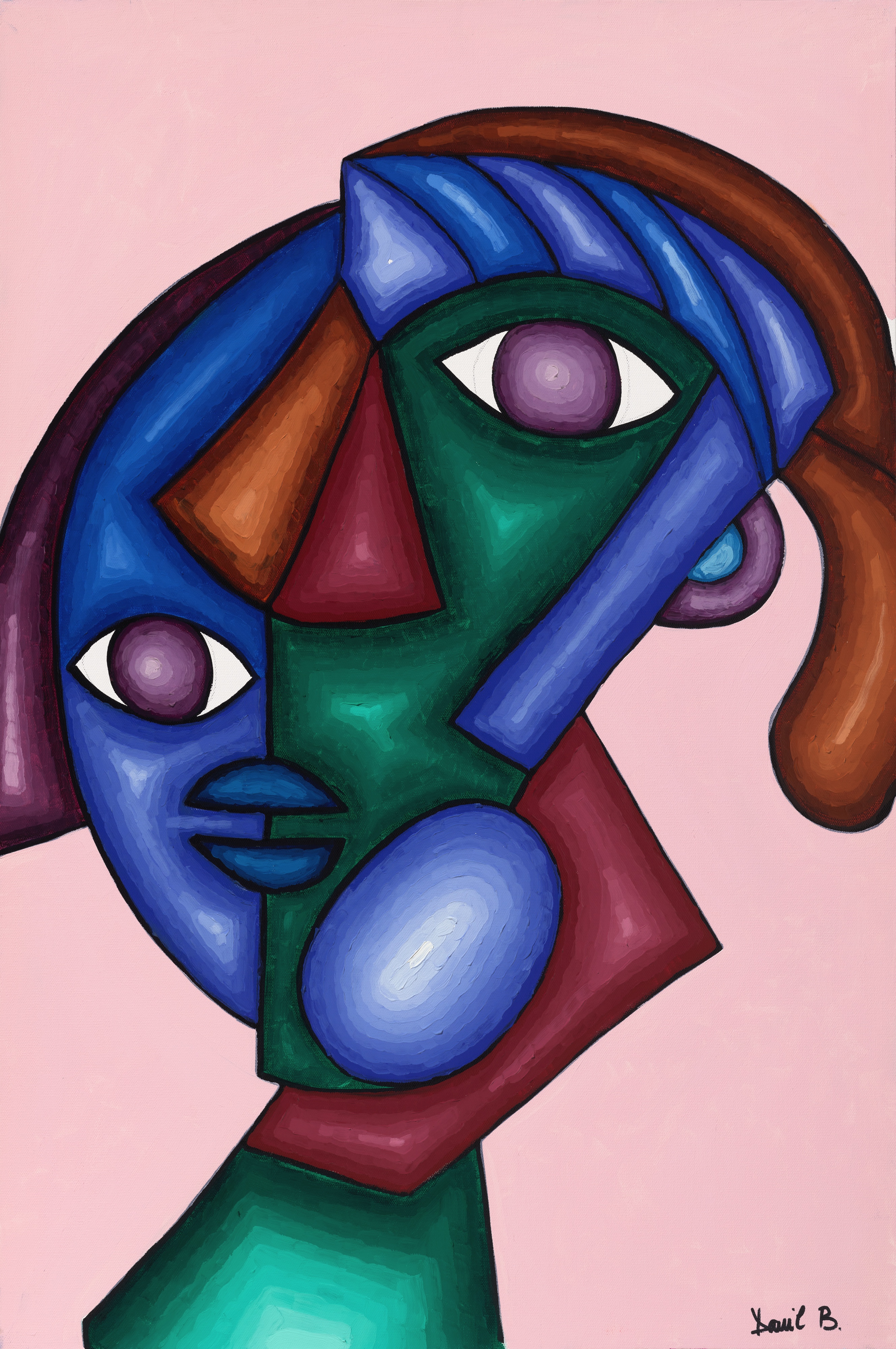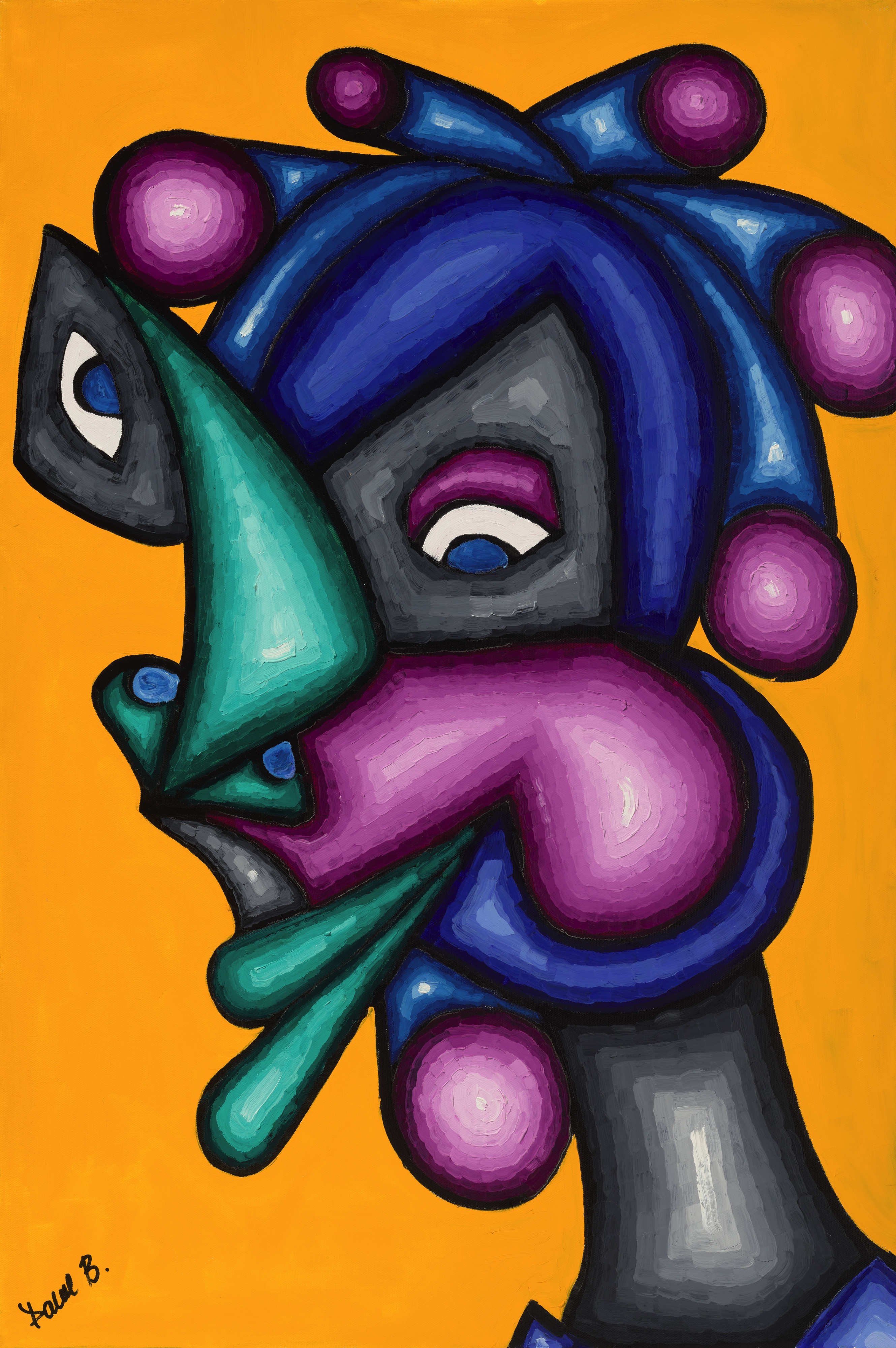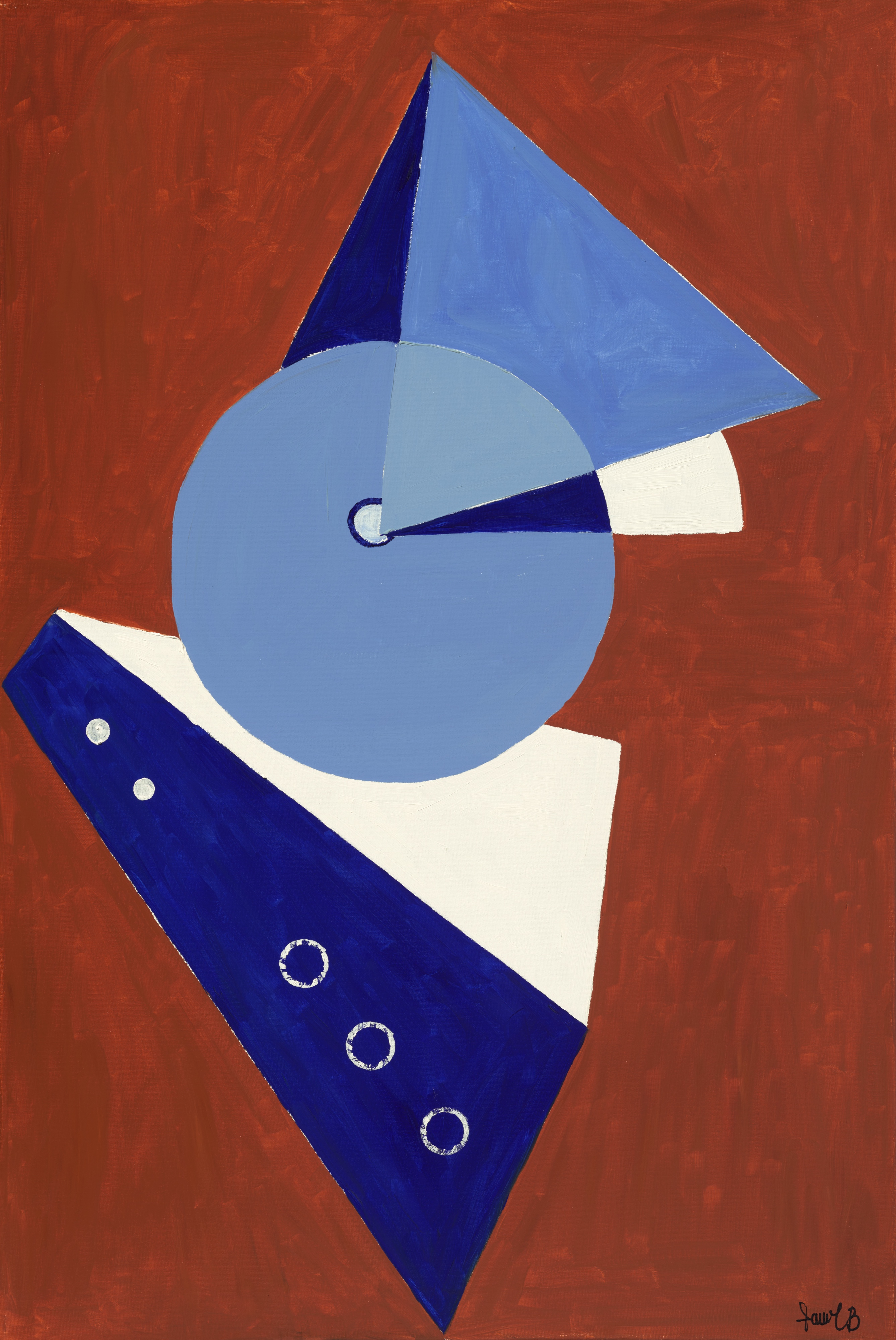Our Latest
Portfolio
The Wanderer
The Wanderer is a portrait of quiet defiance—an ode to those who carry the weight of unseen battles. His sculpted features and solemn gaze are carved with a sense of permanence, as if he has withstood the test of time and emerged not unscathed, but unbroken. The deeply furrowed lines across his brow and the heavy-set expression evoke the spirit of a man who has faced more than his share of hardship, and yet still chooses to stand tall.
The textured sky behind him, swirling with cold strokes of steel blue, mirrors the emotional gravity of a life lived under constant tension. The deep maroon hair hints at internal fire restrained by discipline. There’s no need for embellishment here—his face alone tells the story. It speaks to the countless souls who bore their burdens with quiet strength, especially those shaped by oppression, resilience, and a longing that spans decades. This piece serves as a reminder that depth and beauty are forged in the fires we survive.
The Anointed
The Anointed captures a powerful moment of sacred stillness—a portrait that radiates the solemn weight of calling and the quiet strength of divine appointment. The glowing halo encircling the head is not just a symbol of light, but a deliberate echo of Christian tradition, evoking the ancient depictions of saints, prophets, and Christ Himself. The figure’s expression is firm yet gentle, as if bearing both the sorrow of the cross and the hope of the resurrection.
The exaggerated features are rendered with reverence, not distortion. The long nose, heavy eyelids, and sealed lips speak to a silence filled with wisdom. The purple garment, biblically symbolic of royalty and suffering, reminds us of Jesus before Pilate, robed in mockery but destined for glory. This painting calls to mind Isaiah 53—a man of sorrows, acquainted with grief. Yet through that suffering, there is purpose. A calling. A crown.
The Anointed is a visual meditation on divine purpose carved through pain, a quiet witness to God’s hand at work in unlikely vessels.
Lady of the Lines
Lady of the Lines is a vibrant portrayal of elegance within confinement. The subject's form is defined by sharp contrasts and playful symmetry, while the vertical stripes in the background act as subtle metaphors for societal boundaries. Her composed posture and intense gaze rise above the constraints behind her, suggesting the strength and dignity that persists within restriction. The palette is intentionally bold -sunflower yellow, emerald green, and striking red details radiate confidence and character. Yet behind the saturated colors lies an unspoken tension: the duality of freedom and decorum, individuality and conformity. The layered curves of her neckline and hair echo tradition, while the misaligned eyes hint at the tension of viewing life from multiple perspectives. This piece celebrates the quiet rebellion of remaining fully oneself in a world that asks for conformity.
The Thinker of Timisoara
The Thinker of Timisoara stands as a striking monument to the quiet resilience of the human mind. With its deep cobalt blues and exaggerated features, this 3D portrait channels the presence of a man lost in contemplation, weighted by memory and sharpened by survival. The elongated forms—arched brow, curved jaw, and structured eye—are not distortions but declarations of perspective, sculpted through the lens of hardship. The vertical stretch of the figure evokes both dignity and strain, as if held upright by an inner force too stubborn to bow.
This piece echoes Daniel Burtea’s lived philosophy: “No matter how disfigured, every face is beautiful.” Born behind the Iron Curtain, Daniel endured the suffocating oppression of communism—where to think freely was to live dangerously. This painting is a tribute to those inner sanctuaries of thought, formed in silence when voices could not speak. The sharp gradients of light and shadow emphasize depth, not just physical but emotional, evoking a timeless spirit that refuses to be broken. In its silence, The Thinker of Timisoara shouts with strength.
Swallowed Silence
Swallowed Silence plunges into the deep blue of internal struggle, capturing a surreal moment where voice is both held and hidden. The oversized facial forms—particularly the clenched mouth and piercing eyes—evoke a suffocating tension, as though the figure is caught mid-confession, yet unable to release what haunts it. The seafoam shape in the mouth resembles a symbol or token of truth, forcibly suppressed.
This piece carries undertones from Daniel Burtea’s life journey—where decades under oppression bred a silent strength that eventually broke into color, shape, and motion. Through this work, he does not just reflect on the cost of voicelessness, but confronts it head-on with visual poetry. There is a mysterious serenity despite the tension—a nod to the inner peace that comes not from escape, but from endurance.
Cold Logic
Cold Logic presents a striking fusion of geometry and identity, stripped down to pure monochrome blues. The angular face, constructed from interlocking mechanical forms, stares forward with clinical precision-an ode to the rational mind, restrained emotion, and the systems that confine us. The deliberate symmetry evokes thoughts of artificial constructs, bureaucracy, and the way society often favors order over individuality. This piece resonates with the artist's lived experience under the cold, mechanical control of communism. Every curved line struggling to bend against the rigid framework speaks to the quiet resistance of the soul. The absence of warmth is not accidental-it forces the viewer to confront a world where humanity is filtered through machines, regimes, or expectations. Yet hidden in the blue stillness is a subtle rebellion: a single organic ear, a tilted eye, a nod to the human spirit that refuses to be entirely silenced.
Bunica's Yard
Bunica's Yard is a vivid homage to Daniel Burtea's grandmother and the humble countryside life that shaped his early memories. Set against the textured wall of a Romanian village home, the painting bursts with emotion and color, capturing a way of life marked by resilience, simplicity, and the quiet dignity of hard work. Her broad hands, worn by decades of labor, rest at her sides as blue-feathered chickens peck at the mosaic-like earth-symbols of both sustenance and routine. Every detail in the composition holds a piece of her story-from the cracked steps and worn bucket to the sickle painted faintly on the wall, an ominous reminder of the communist regime that loomed over rural families like hers. Yet within the scene, a quiet joy emerges-the flowers under the window, the neatness of her door, and the familiar domestic rhythm that communism could not steal. This painting is not merely nostalgic; it is a preservation of legacy. Through thick brushstrokes and bold hues, Daniel honors the woman who kept faith, family, and tradition alive in a world that often tried to strip them away.
Whispers Between the Eyes
Whispers Between the Eyes captures a haunting duality—a single face rendered with mirrored symmetry, yet filled with quiet tension. Two gazes peer outward, their exaggerated, expressive shapes caught in a suspended conversation, as if secrets are being passed silently between them. The sculpted strokes of blue tones and soft shadows build dimension and weight, giving the painting its near-sculptural effect. Hair cascades down both sides like a shroud of thought, framing a mouth that coils shut like a symbol of guarded truths.
This piece reflects a deeper layer of Daniel Burtea’s artistic voice—a meditation on self-reflection, internal conflict, and the unspoken prayers that dwell in silence. It’s a visual manifestation of what it means to carry contradiction: strength in softness, expression in restraint, solitude in symmetry. The face is distorted, yet deliberate, reminding us that beauty is not the absence of fracture, but the presence of depth.
One Who Wonders
The One Who Wonders is a portrait suspended between thought and expression—a figure caught mid-reverie, where questions outweigh conclusions. The face, constructed from a brilliant weave of jewel-toned contours and asymmetrical geometry, is both fractured and whole. The intense gaze, peeking through layers of indigo, emerald, plum, and sapphire, suggests a searching soul—someone who listens not only with their ears but with their eyes, lips, and heart. The stylized gloved hands gently positioned at the base give a sense of grace, suggesting a posture of readiness, patience, or even prayer.
There is something delicate yet powerful in this piece, like a person who has seen hardship but still greets the world with curiosity. The sloping neck stretches upward with elegant tension, carrying the full weight of a complex mind on its slender base. This painting feels like a mirror for anyone who’s ever looked to the sky and asked, “What’s next?”—not with fear, but with wonder. It’s an invitation to keep questioning, keep hoping, and keep watching for signs in the noise.
Woman of the Borderless Sky
Set against a background that feels like a sky torn between chaos and transcendence, Woman of the Borderless Sky is a celebration of fractured beauty, resilience, and rebirth. Her body is assembled from symbolic shapes-each eye, limb, and pattern seemingly borrowed from different stories, stitched together into a single figure radiating bold color and strength. Daniel Burtea's choice of lines is both playful and deliberate, creating a visual language of movement and heritage. The woman reclines in a posture of quiet defiance, looking directly at the viewer- curious, unbothered, aware. There's rhythm in the repetition of color and a sense of ancient narrative in her form. The work speaks of displacement and adaptation, of how cultures and people blend in exile. This is a woman who has carried her past into a place that cannot define her—a borderless identity made visible through art.
Two Eyes, One Soul
Crafted with Daniel Burtea’s signature multi-tone brushstroke technique, Two Eyes, One Soul bends dimensionality to draw you into the emotional interior of a divided face. At first glance, it appears to be two figures-two identities— sharing space. But as you stare deeper, it becomes clear: this is one being caught between two worlds.
The warm and cool contrasts-the rust-toned earthiness and the tranquil blues and greens— speak of duality: past and future, masculine and feminine, East and West. The eyes, though separate, mirror each other with subtle unity, inviting viewers to reflect on their own inner contradictions.
This piece tells the story of migration, integration, and identity-of one who has been torn yet made whole through the act of survival. It is an homage to the complexity of the immigrant experience, rendered with such sculptural depth that the face appears to reach out from the canvas and whisper,
“I have seen, and I am still becoming.”
Blue Silence
Divided But Whole
In Divided But Whole, Daniel Burtea deconstructs the human face to expose the emotional fractures we often conceal. With bold, angular lines and asymmetrical geometry, the figure is split between dual tones of blue-each side representing opposing forces: vulnerability and strength, conformity and rebellion, past and present. The singular eye gazes outward with a mix of innocence and hesitation, a silent plea to be seen fully-even in fractured form. Her hair, flowing in rhythmic contour, symbolizes continuity, a tether to identity amidst distortion. Set against a deep terracotta backdrop, the coolness of the subject's expression is thrown into sharper relief-perhaps a commentary on isolation within a world teeming with noise and color. Burtea challenges us to see beauty not in perfection, but in fragmentation. In a world where wholeness is rare, Divided But Whole reminds us that our inner divisions don't diminish our humanity—they define it.
Womb of the World
The faceless mother figure is both universal and deeply personal. Her rounded form suggests fragility, yet her position-tightly curled and contemplative-conveys resilience and guarded hope. The green veil draped across her back evokes shelter and a sense of origin, while her grounded toes and fingertips clutch the air, as if bracing for the unknown.
This painting is a meditation on the tension between safety and exposure, between being held and letting go. In a world that can feel fragmented and cold, Burtea gently reminds us that life itself is a miracle-cradled in layers of pain, perseverance, and grace.
Holding It Together
In Holding It Together, Daniel Burtea captures the quiet agony of composure. The woman in the painting appears fractured yet adorned, her limbs and features angular and disjointed, her expression caught between grace and grief. The swirling, chaotic background mirrors the internal turmoil she hides behind a rigid pose and a flower pinned to her chest-an emblem of forced beauty in the face of personal unraveling. Her brightly colored hair, almost halo-like, hints at a former innocence or joy, now boxed in by the jagged lines of survival. Every stroke is purposeful, every color layered with contradiction: the soft lavender against the piercing green of her tearful gaze, the polished nails gripping her arm in subtle desperation. This work is a study in the emotional balancing act familiar to so many women-of appearing strong while carrying invisible burdens. It's an homage to those who smile while breaking, who carry color in their spirit even when their world is drawn in sharp lines.
Where Silence Weeps
Where Silence Weeps is a haunting tribute to hidden sorrow. Sculpted with Daniel Burtea’s signature 3D technique, this portrait emerges from rich, undulating purples-each brushstroke a contour of emotional depth. The figure’s distorted yet dignified face is pierced by luminous green eyes and a clenched emerald mouth, as if holding back a scream.
But it’s the golden tears that reveal everything.
Delicately suspended, they fall from each eye like sacred confessions-proof that even in silence, the soul finds a way to speak. These tears don’t scream; they shimmer. They don’t beg for attention; they bear witness.
Set against a swirling violet backdrop, the figure becomes a monument to grief held in grace. It challenges the viewer not to look away, but to look deeper.
This piece invites collectors into a space where pain becomes poetry and brokenness is reframed as beauty.
Golden Divide
Golden Divide is a bold exploration of duality-light and dark, seen and unseen, harmony and division.
Rendered in Daniel Burtea’s signature 3D technique, the face is split into two contrasting halves, yet fused by shared vision. The radiant golden side exudes warmth and openness, while the earthy, shadowed side speaks to depth and introspection.
The vibrant halo-like yellow backdrop suggests a spiritual illumination-perhaps the light that emerges from within those who have endured. The emerald eyes, striking and centered, reflect a gaze that is both protective and piercing, asking not for understanding but acknowledgment.
This work is an ode to those who wear multiple identities yet remain whole-those who have walked through both fire and shadow to become beacons for others.
The Stoic Rooster
The Stoic Rooster presents a commanding blend of form and simplicity-its bold, geometric silhouette crafted with Daniel Burtea’s signature 3D technique. The piece captures the essence of resilience and grounded pride, rendered through sculptural strokes and a striking interplay of deep charcoal and crimson tones.
Set against a serene blue backdrop, the rooster’s posture is both upright and unyielding-evoking a quiet strength and a contemplative spirit. Every angle and curve is intentional, drawing the viewer to reflect on themes of identity, voice, and vigilance.
This work transcends literal interpretation, transforming a humble farmyard symbol into a monument of presence and power.
Echoes of Her Gaze
Echoes of Her Gaze is a striking portrait that radiates both vulnerability and power. Sculpted in Daniel Burtea’s dimensional 3D technique, the figure’s deep indigo tones and flowing contours convey a sense of quiet strength wrapped in introspection. Her oversized eyes seem to search and remember simultaneously-pulling the viewer into her world of silent memory.
The exaggerated features are not distortions, but exaggerations of emotion—an artistic expression of the unseen depths that define a person more than symmetry ever could. Framed by soft, ruffled edges in turquoise, she embodies grace under pressure, delicacy paired with resilience.
In this piece, Burtea invites us to dwell on the quiet echoes of our own emotional landscapes-those inward moments we rarely share but all feel.
Breath of the Invisible
Breath of the Invisible distills the human form into its most essential, abstract elements. With warm, sculpted strokes and a serene blue background, Daniel Burtea evokes the suggestion of a face without fully defining it-inviting the viewer to pause and interpret.
The gentle arcs in the background add a sense of movement, like soft ripples or waves of sound, creating rhythm without distraction. Every curve and contour feels intentional, balanced between structure and simplicity. This piece captures a quiet moment of introspection, where expression is found not in detail, but in the spaces between.
Rhythms of Her Own
In Rhythms of Her Own, Daniel Burtea fuses movement, form, and vibrant geometry into a celebration of unrestrained expression. The figure-rendered in bold, flowing black lines-twists freely across a field of layered color, unapologetic in her posture and presence. Her body, abstract yet unmistakably feminine, defies conventional framing, instead claiming the entire canvas with fluidity and power. The dynamic blocks of orange, teal, yellow, and violet create a pulsating backdrop, each shape adding rhythm to the composition, like a dance captured mid-beat. There is joy here, but also bold defiance-a visual declaration of autonomy, energy, and individuality.
The Listener
The Listener evokes a quiet, unshakable presence—an abstract portrait of someone who watches, absorbs, and understands far more than they speak. With layered shades of emerald and cobalt, the figure’s form feels fluid yet grounded, as though sculpted from the ocean itself. The eyes—one looking forward and the other slightly turned—create a sense of dual awareness, as if perceiving both the outer world and the thoughts unspoken within it.
The elongated features, especially the ear-like shapes and attentive posture, turn this subject into more than a person; they become a vessel for stories untold, pain endured, and wisdom passed on in silence. In a world overflowing with noise, The Listener stands apart—a quiet guardian of discernment, compassion, and inner strength.
Color Theory
Color Theory explores the illusion of depth through tonal contrast and bold structure. While not sculpted or part of Daniel Burtea's 3D collection, the piece mimics dimensionality through strategic lighting, shading, and color placement. Saturated blues, greens, and reds emerge like carved forms, casting visual shadows against a stark black background and flowing white hairline contours. The subject's fragmented face is assembled with geometric intensity, yet softened by curvature and expressive asymmetry. With every angle, Burtea challenges the eye to distinguish between surface and form, illusion and essence. It is a cerebral meditation on perception-where flatness feels sculpted, and color alone becomes architecture.
Balance and Orbit
Balance and Orbit is a quiet meditation on stability amid complexity. With calculated geometry and bold minimalism, the composition evokes a sense of gravitational pull-two orbs, caught in precise triangular beams of light, appear to stabilize and suspend one another in an abstract but intentional symmetry. The interplay between the deep blue foundation and the golden yellow accents suggests the tension between grounded presence and radiant ambition. The warm half-sun hovering above echoes the rhythm of cycles-sunrise and sunset, action and rest, rise and return. Behind the simplicity of form lies the weight of discipline, clarity, and the silent pursuit of equilibrium in a world that never stops shifting.
American Gaze
American Gaze stands as a tribute to the enduring spirit of a nation defined by resilience, diversity, and relentless hope. The figure-fragmented yet composed-represents the multifaceted identity of the American people, each line and color a reflection of voices woven into the nation's fabric. Against the bold backdrop of the flag, the subject looks forward with quiet strength, embodying both the burden and the blessing of freedom. This painting calls the viewer to remember that patriotism is not perfection, but the courage to grow, to question, and to carry the dream forward-generation after generation.
Split Perception
Split Perception captures the tension between logic and emotion, mind and spirit. The bold symmetry, broken only by deliberate distortions, mirrors the internal battle between reason and instinct—between the clarity of thought and the unpredictability of feeling. The triangular yellow form evokes a guiding light or divine revelation, cutting through the layers of distraction. With sculpted contours and layered textures, this 3D work reflects a life shaped by trials, discipline, and a refusal to yield to confusion. It is a meditation on strength of mind, integrity, and the pursuit of clarity in a world that often blurs the lines.
Iron Resolve
The Defector
The Defector captures the psychological rupture of leaving behind a world of control and deception in search of truth. The face is split-one eye wide open, the other dulled by indoctrination-symbolizing the tension between awakening and illusion. The decorated uniform and proud stance contrast sharply with the twisted, chaotic expression, as if to say that surface-level honor can mask inner dissonance. It speaks to those who break ranks not out of rebellion, but out of moral clarity. This painting honors the internal war of those who defect from systems that demand loyalty at the cost of conscience.
The Unmoving
The Unmoving depicts a face frozen in stoic stillness—bulbous, heavy, grounded. The nose dominates the composition like a mountain carved by time, while the mouth sits silent, turned downward in a subtle frown that suggests weariness without surrender. The figure’s eyes, sunken yet alert, gaze from opposite sides of the face, symbolizing a perspective shaped by conflict—seeing from both ends of experience, but speaking from neither.
Surrounded by a textured haze of muted brushstrokes, the subject appears immovable, both in body and spirit. Dressed in cobalt blue, a color often associated with resilience and truth, the figure wears quiet strength like a uniform. This piece reflects the kind of endurance that doesn’t announce itself—one that comes from carrying more than a moment, more than a burden. It is a portrait of someone who has endured and who continues to endure, unmoved by the chaos around them.
The One Who Listens
The One Who Listens captures the tension between silence and internal dialogue. Rendered in vibrant hues of violet, blue, and emerald green, this portrait doesn’t shout—it watches, absorbs, and evaluates. The figure’s angular composition and exaggerated features suggest alertness, as if each ear and eye is a radar tuned to hidden frequencies in the world around him. Despite the fragmented geometry of his form, there is cohesion in the gaze—a knowing stare that reveals someone who sees what others miss and says little about it.
There’s a playfulness to the colors, but not without weight. This is the kind of person who has learned that laughter is a form of survival, and that paying close attention is more powerful than speaking too soon. His grin is slight, but his posture leans forward, curious, analytical, and reserved. In every color block and every edge, we see not only the contours of a face but the layers of thought, memory, and discipline—earned over time and trial.
Golden Tempest
In Golden Tempest, Daniel Burtea expresses the whirlwind of human emotion through radiant brushstrokes and fragmented composition. The vibrant spirals of golden hair erupt across the canvas like solar flares-each curl a burst of thought, memory, or raw energy. The dual gaze-one eye turned outward, the other inward-reflects the contrast between inner reflection and external perception. The textured skin, made of layered dabs in soft, earthy tones, resembles the complexity of lived experience-imperfect, yet undeniably beautiful.
Set against a rich cobalt background, the figure emerges with intensity and grace. The swirling strokes in the hair and face suggest motion and unrest, yet the subject remains composed, grounded, and proud. Golden Tempest is a portrait of strength in turbulence-a testament to beauty that grows through struggle, and identity that shines even when fractured.
The Daily Bread
The Daily Bread captures the raw humility of labor, drawing from the artist's early life marked by poverty, hunger, and survival. The figure, unclothed and unguarded, stands as a symbol of resilience-kneading not just dough, but years of struggle, endurance, and quiet strength. The purple floor beneath her, rich and bruised, evokes both royal dignity and the bruises left by a hard life. Behind her, the simplistic setting is interrupted only by a framed window of nature— perhaps a dream, or a memory-offering a stark contrast to the immediacy of her task. The figure's posture, somewhere between grace and exhaustion, becomes a sacred gesture, honoring every sacrifice made in silence. This painting is a reflection of the everyday sacred, the act of creating sustenance with one's own hands, and the solemn, quiet beauty of doing what must be done.
Weightless in the Fire
Weightless in the Fire presents a paradox of form and feeling-a figure sculpted from rounded, exaggerated masses floats against a golden backdrop scattered with spheres of glowing blue. Though heavy in shape, she appears unbound by gravity, suspended mid-motion as if dancing through invisible tension. Her expression is stoic, almost detached, yet her body twists with purpose-resilient, enduring, alive.
This piece evokes a memory of the kind of woman forged in hardship and simplicity, the type who worked without complaint and carried the weight of generations. She is both myth and memory-perhaps a whisper from the rural past, where survival required more than strength. It required surrender to pain without losing oneself. In the chaotic geometry of her limbs and the ordered beauty of the spheres around her, we glimpse the quiet battle to hold on to dignity when the world presses in.
Silent Gaze
In Silent Gaze, Daniel Burtea captures the profound stillness of a soul suspended between thought and truth. This 3D portrait emerges from the canvas with sculptural precision, each bold contour shaped by his signature brushstroke technique.
The earthy browns and sepia tones create a warm yet solemn atmosphere, evoking strength formed in silence.
The figure’s gaze is direct yet distant, as though watching something long gone-or perhaps not yet arrived. Its face, constructed from exaggerated forms and softened edges, reflects a life shaped by quiet resilience and unspeakable endurance.
This work is a tribute to those whose voices were never heard, yet whose presence changed the course of everything around them. It stands as both a question and a monument.
Wired Within
Wired Within is an abstract portrait etched with quiet tension and introspective depth. In this work, Daniel Burtea uses monochromatic tones and sharp linear forms to depict the complexity of the human psyche. The face, constructed from a network of interwoven paths, resembles both a topographical map and ancient tribal carvings- timeless, sacred, and deeply personal. The expression is cryptic yet alert, as if the figure is caught mid-thought, processing a memory too fragile to speak aloud. The sepia tones ground the piece in warmth and nostalgia, while the intricate linework suggests a life lived through mazes-each twist and turn, a story untold. With Wired Within, Burtea offers a glimpse beneath the surface-a reminder that even in minimalism, there is infinite depth.
Rest by the Shore
In Rest by the Shore, a woman rests with her eyes closed, her posture forming a triangular harmony that evokes strength and peace. Rendered in calming grays against a golden yellow background, she is both monument and mystery-her form recalling sacred icons and stone-carved figures, yet softened by serenity. The waves below suggest a rhythmic lullaby of life's ongoing flow, while the sun, partially revealed in the corner, hints at a divine presence watching over.
This piece reflects the artist's spiritual foundation and Romanian heritage-where simplicity meets symbolism, and the soul is often depicted not in grandeur, but in rest. It's a tribute to inner stillness, strength through surrender, and the quiet resilience of the human spirit.
The Patriot
The Patriot is a commanding tribute to those who carry the weight of duty with both pride and pain. The fractured symmetry of the figure reflects the personal cost of service-honor worn like armor, yet marked by sacrifice. Draped in uniform blue against the bold stripes of the American flag, the subject becomes a living emblem of national resilience. Every geometric edge, every color, is a deliberate nod to valor, discipline, and the enduring spirit of those who stand for something greater than themselves. This piece reverberates with love of country, respect for tradition, and the quiet strength of those who serve.
Bond Without End
Bond Without End captures the moment where two identities collide, not in conflict, but in deep and inseparable connection. Their faces interlock like pieces of a divine puzzle—distinct, yet shaped by each other’s presence. Vivid reds streak through emerald and earth tones, creating a visual rhythm that pulses with emotion. Eyes gaze in different directions, yet their unity is undeniable. It is not about agreement, but about becoming one despite difference.
In this piece, Daniel Burtea reveals the profound beauty in union—where love requires neither words nor symmetry, but presence and acceptance. There is intimacy here that goes beyond romantic affection; it speaks to the sacred bond between souls destined to meet. Whether interpreted as family, lovers, or kindred spirits, the painting reflects a truth known by experience: that some connections cannot be explained, only felt—and never broken.
Blue Gaze
Blue Gaze invites viewers into a moment of introspection— sharp, elegant, and silent. The angular contours and monochromatic blues speak of solitude and clarity, while the deep stare suggests a soul measuring the world with caution and precision. Framed by a rich, earthy background, the face emerges like thought breaking through noise. The elongated nose, almost like a sundial, points to time passed in silence and restraint. This painting captures the pause before action, the weight behind every gaze, and the strength found in stillness.
Vertical Acrobatics
Vertical Acrobatics captures the whimsical defiance of gravity and limitation, echoing Daniel Burtea’s relentless ascent through impossible odds. The figure, twisted and mid-motion, reflects the surreal contortions life demanded of the artist in his youth—fleeing communism, rebuilding identity, raising a family, and mastering reinvention. The vibrant 3D geometry evokes a sense of upward struggle and inverted joy, a visual metaphor for finding light by flipping darkness on its head. Every color, every curve, pulses with a refusal to settle. It’s a triumphant tribute to resilience, vision, and the freedom that comes when one refuses to fall.
Side by Side
Side by Side captures the raw simplicity of love-playful, imperfect, and bold. With intersecting forms and complementary colors, the figures lean into one another, echoing the kind of union that doesn't need to be explained. The asymmetry of their embrace suggests life's unpredictability, while their unified posture speaks to the quiet strength of shared presence. This piece is a celebration of togetherness—a reminder that true connection isn't found in perfection, but in the choice to walk forward, side by side
The Watchman
The Watchman gazes outward with eyes that seem to pierce both dimensions—paint and soul. The figure’s vibrant, purple face and deep blue eyes hold the solemnity of a sentinel, a guardian who has witnessed the rise and fall of dreams. His emerald coat wraps him like a mantle of duty, his gaze unwavering, as if holding the line between chaos and peace. This piece captures the essence of resilience—of those who silently carry the weight of vigilance, bearing burdens not for recognition, but because it is right. Behind the surreal contours lies a life forged in hardship, strength, and immovable conviction.
The Weight Within
The Hustler
The Hustler captures the electric charisma of survival. With a mischievous grin and wild, brilliant eyes, the figure is sculpted with exaggerated swagger—each curve and contour reflecting confidence carved out of hardship. There’s grit behind the smile, and ambition in every shadow. This 3D piece radiates the street-smart energy of someone who’s seen the struggle, learned its rhythm, and now plays it like a game. It’s not just a face—it’s a whole attitude. A reminder that resilience often wears a grin, even when it’s grinding.
Quiet Resolve
Quiet Resolve captures a solitary figure turned inward, shoulders slightly hunched, face angled down—not in defeat, but in deep, contemplative strength. The sculpted curves of the form, rendered in deep navy and warm rust tones, exude a tactile realism that elevates the emotional weight of the piece. The figure’s sealed lips and closed posture suggest a person who has endured without complaint, one who knows the cost of speaking too soon or too often.
This piece speaks volumes in silence. It honors those whose resilience doesn’t demand recognition, whose courage is found not in battle cries but in stillness and steadfast endurance. Every rounded edge and softened plane is a tribute to discipline, humility, and the quiet power of choosing to carry one’s burdens with dignity.
Echoes in the Spiral
Echoes in the Spiral captures the emotional complexity of a soul shaped by hardship and triumph. The dual-toned face—rich brown skin paired with vivid blue and green details—speaks to the quiet strength of those who have endured much but remain unbroken. The exaggerated spiral in the hair draws the eye inward, mirroring the never-ending internal dialogue of reflection and resilience. Her lips, painted in piercing blue, are sealed yet full of unspoken testimony—words shaped by wisdom, not bitterness.
The eyes, positioned asymmetrically yet wide open, symbolize the dual perspective of one who sees both what is and what could be. There is a deep-rooted sadness balanced by regal calm—one that only comes from generations who carried burdens quietly and kept moving forward. With its sculptural lighting and depth-enhancing colors, this 3D painting evokes the solemn dignity of ancestry, heritage, and the enduring pulse of hope.
The Watchful Side
The Watchful Side unveils a portrait of dual perception—an inner world colliding with the outer gaze. One eye faces outward, bold and alert, while the other remains turned inward, quiet and contemplative. The face is composed of fragments in deep blue, forest green, and dusky red, assembled like the thoughts and feelings we try to keep in balance. It’s a reflection of how we navigate life: aware of what others see, yet still deeply affected by what only we can feel.
Daniel Burtea’s composition reminds us that everyone walks with both courage and caution. Behind every outward strength lies an inward tenderness we guard carefully. This painting is for those who carry a quiet strength—those who notice, who reflect, who hold their voice until it’s time to speak. In the world’s noise, they see clearly. And in stillness, they see deeper still.
The Jester’s Reflection
In The Jester’s Reflection, Daniel Burtea explores duality with sculptural depth and vibrant theatricality. This 3D painting bursts forward in form and hue-cool blues and greens clash with radiant magentas and purples, animated against a golden backdrop. The jester-like figure, both abstract and emotive, wears a crown of bulbous ornaments, suggesting festivity while simultaneously hinting at internal complexity.
With its exaggerated features and layered geometry, the piece presents a face split between joy and contemplation-two expressions coexisting within one identity. Burtea invites us to look beyond the performance and into the hidden truths that lie just beneath the surface.
The Observer
The Observer presents a figure whose essence lies in the act of watching, not merely seeing. With eyes enlarged and fixed, one higher than the other, the subject gives the impression of heightened awareness—perceiving the world in layers others might miss. The long, narrow nose cuts the composition in two, suggesting the division between inner truth and external appearance. The design is minimal, yet precise, with every curve and angle carrying intention.
This 3D piece is sculpted with a sense of stillness and precision, a study in presence and discernment. The vibrant teal eyes are wide open, but the mouth remains silent—perhaps because some truths are better witnessed than spoken. The soft gradient sky behind the figure offers contrast to the saturated tones of rust, brown, and charcoal, grounding the subject in solitude. This painting invites viewers to step into the role of the observer themselves—to pause, reflect, and truly see.
Precision in Chaos
Precision in Chaos is a striking departure from figurative form, inviting viewers into the language of geometry and symbolism. Clean, angular lines intersect with circular elements on a burnt sienna backdrop, suggesting both conflict and balance-chaos framed by order. The deep navy and sky blue tones evoke depth and clarity, while the white cuts through with surgical precision, as though slicing time itself. This painting captures a moment of alignment between randomness and intent-where spontaneity meets strategy, and meaning is found in motion. It is a contemplative work that urges the viewer to see beyond the surface, into the carefully layered decisions that shape every seemingly random turn in life.

